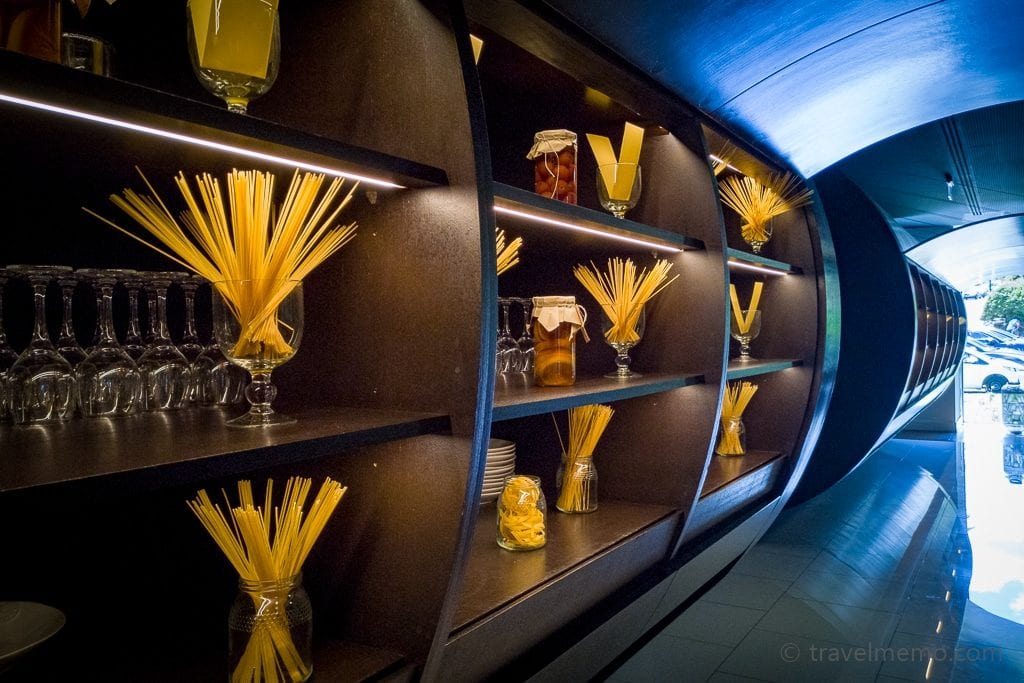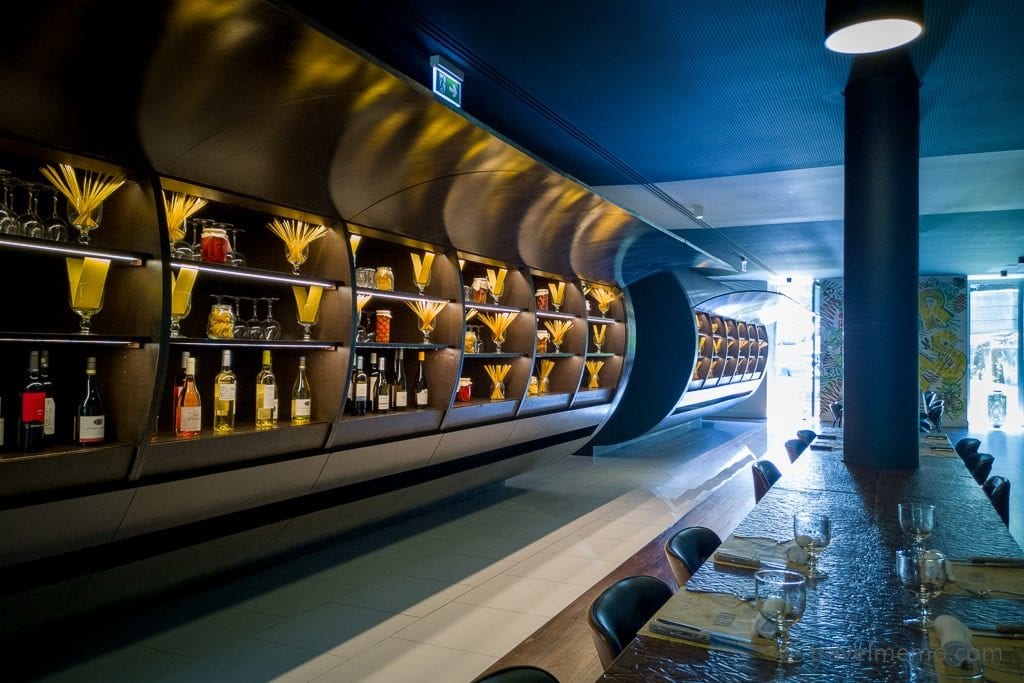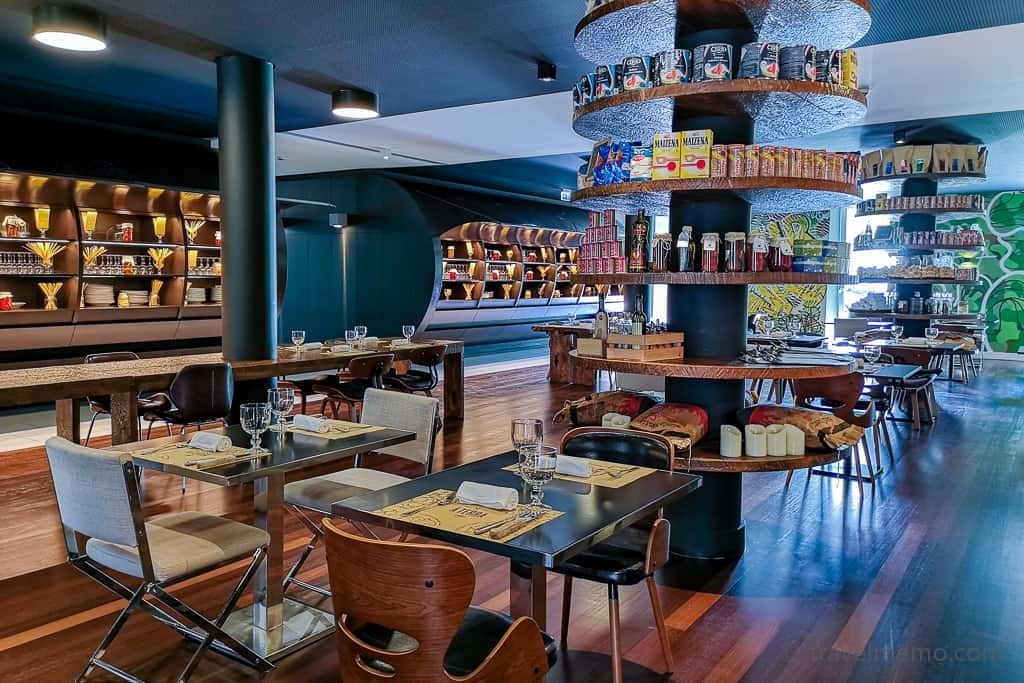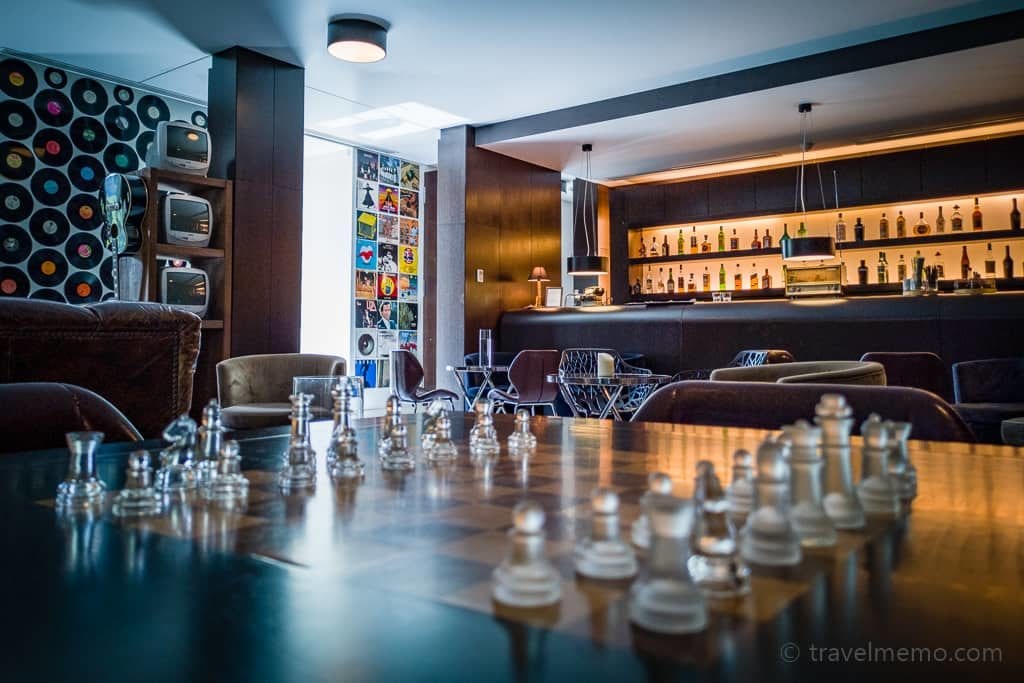São Miguel, the main island of the Azores chain is also the largest one. It is often called “the green island” because of the flora that covers it.
This guide first appeared in German on reisememo.ch
I like to think of it as more of a blue-green island. Read my highlights and tips to find out why!
We had actually planned a trip to Scotland for 2018. I wasn’t all that fired up for it on account of the weather. I like vacationing in nice warm places where the wind doesn’t blow or its constantly cloudy if it’s not raining.
So, in the end, we booked a flight instead to the…Azores! At that point, I did not (yet) know that the weather in the Azores can also be capricious!
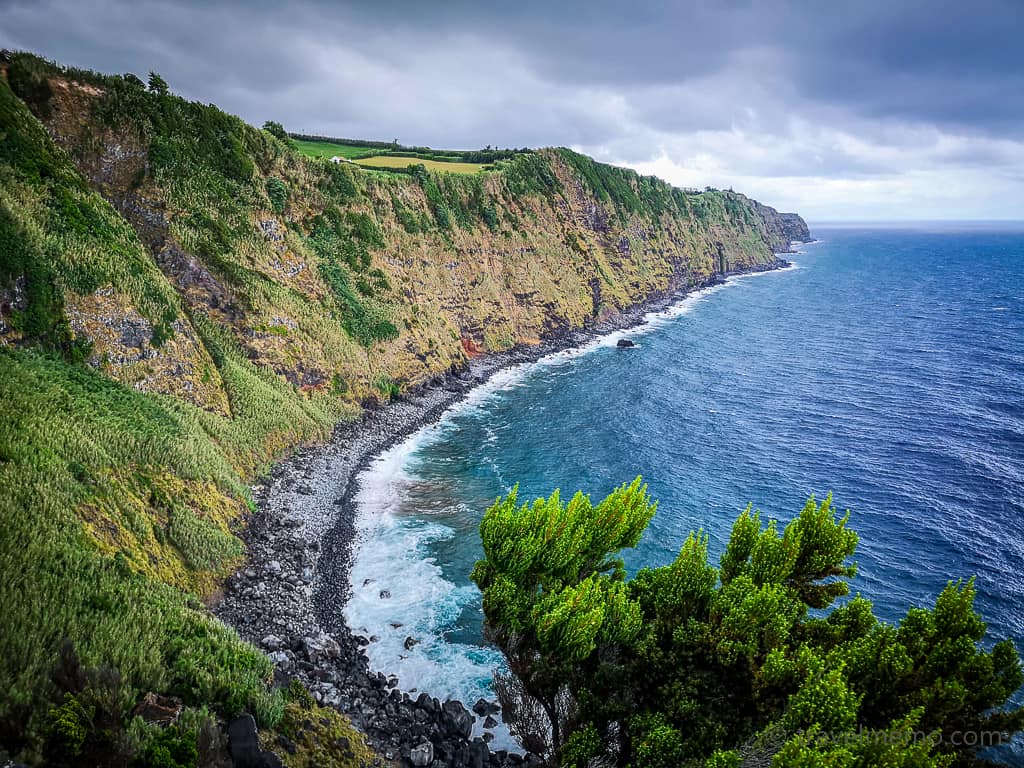
About the Azores and the famous Azores High
The Azores island chain belongs to Portugal and is located nearly in mid-Atlantic, some 900 miles west of the mainland. It consists of nine volcanic island of assorted sizes ranging from large to small.
As we never cease to hear from the weatherman, during the summer the Azores High atmospheric pressure often blesses us with seasonal sunny weather in central Europe. I naively assumed that on the Azores constant sunshine and summer warmth awaited us.
That, however, I learned is not always how it plays out there. Frequently, a bubble of humid air will sit over the Azores that, depending on wind direction and force, can pile up against the mountains, resulting in variable weather.
Year-round, you can expect wind, fog, and rain alternating with sunshine. The locals have a saying that on the Azores you can experience the four seasons all in one day. Well, at least it doesn’t snow, too…
So, besides the swimming trunks, there should definitely be a rain jacket in your suitcase!
Green São Miguel Island
At 39 miles in length and 16 miles wide at its widest point (287 square miles), São Miguel is the largest and also the main island in the archipelago.
One reason I think of it as the blue-green instead of just “the green island” as it is usually called is that never have I seen so many blue hydrangeas and rhododendrons anywhere.
The hedgerows run on for miles, they seam pastures, streets, and blocks of houses. The island in some places looks like it is floating in a sea of blossoms.
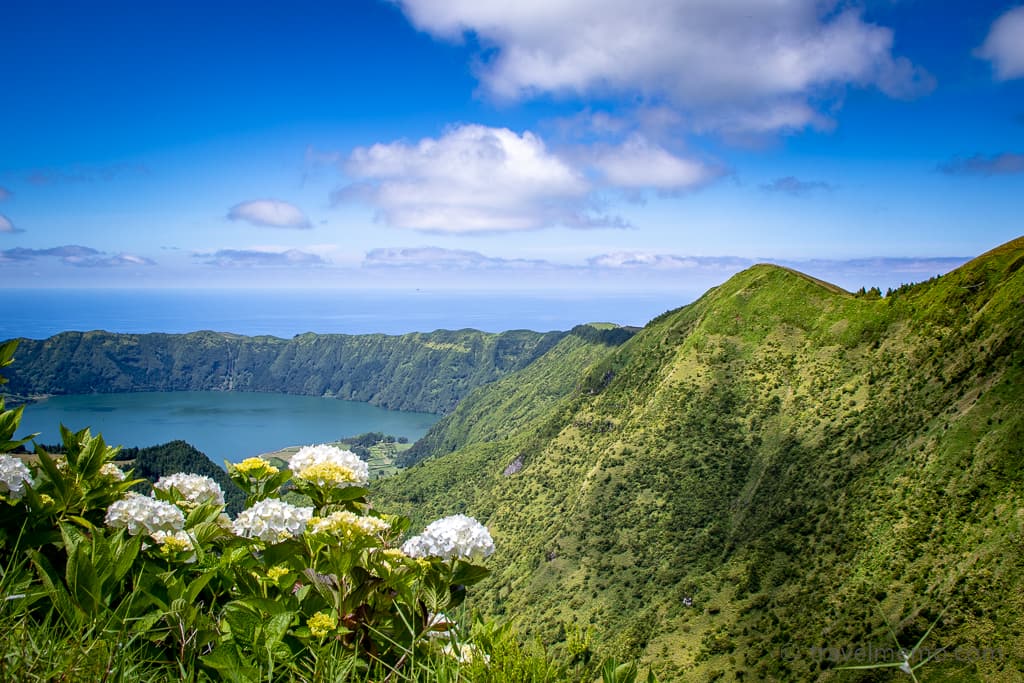
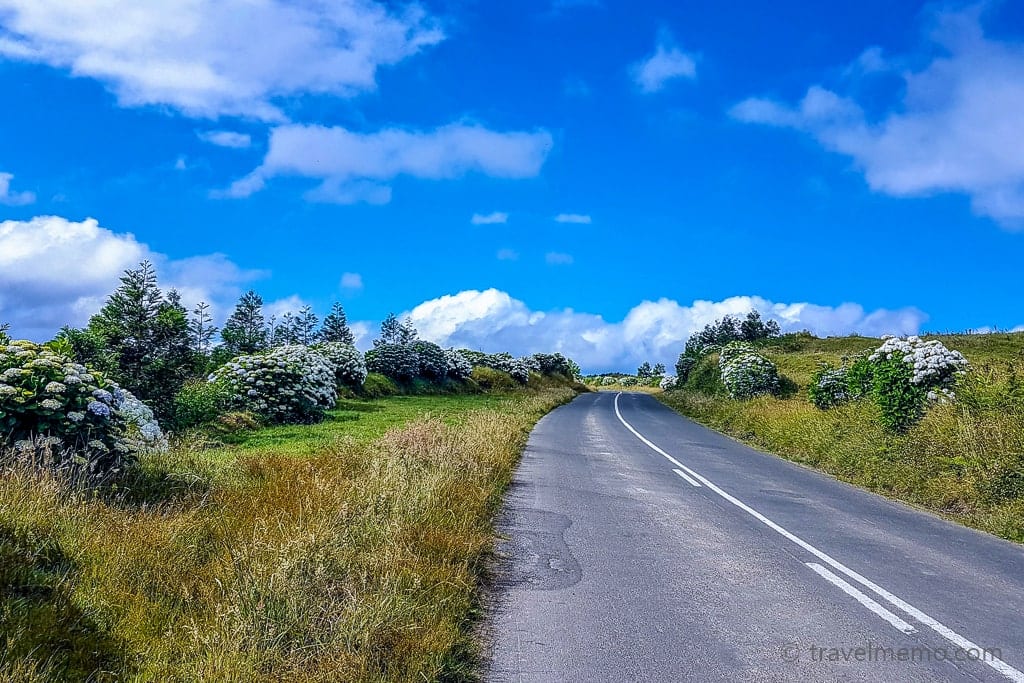
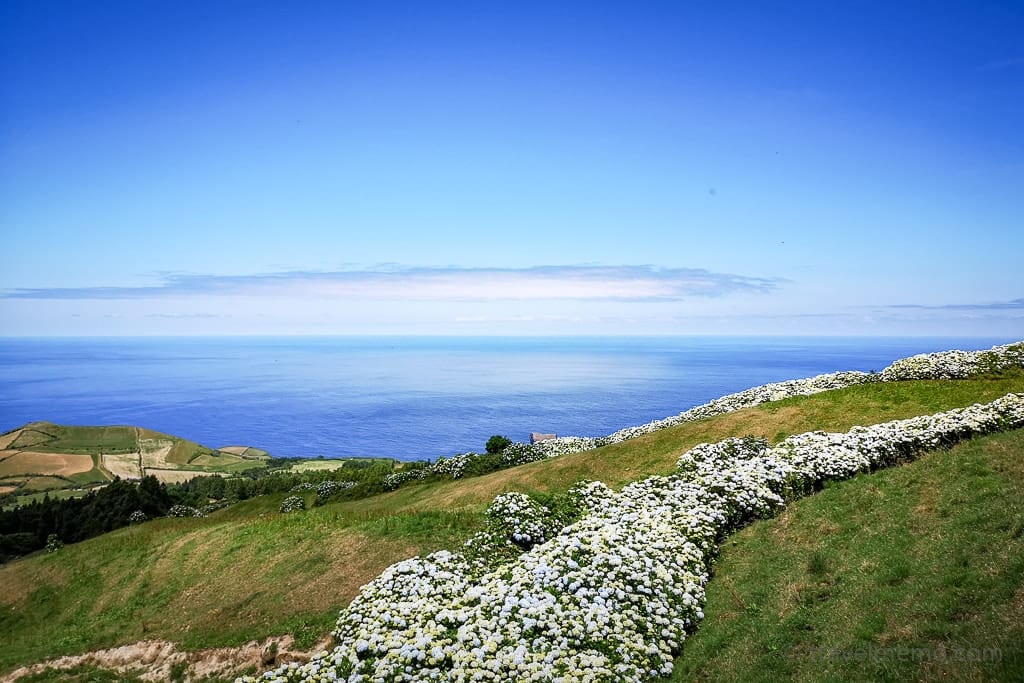
On top of that, of course you often get views of the Atlantic, which also combines blue and white. A color feast for eye and senses!
Mixed in from time to time, besides a drizzle, are black-and-white dots. Those are the black-and-white cows that peacably graze on lush green pastures. At times I almost feel like I landed in Scotland after all!?
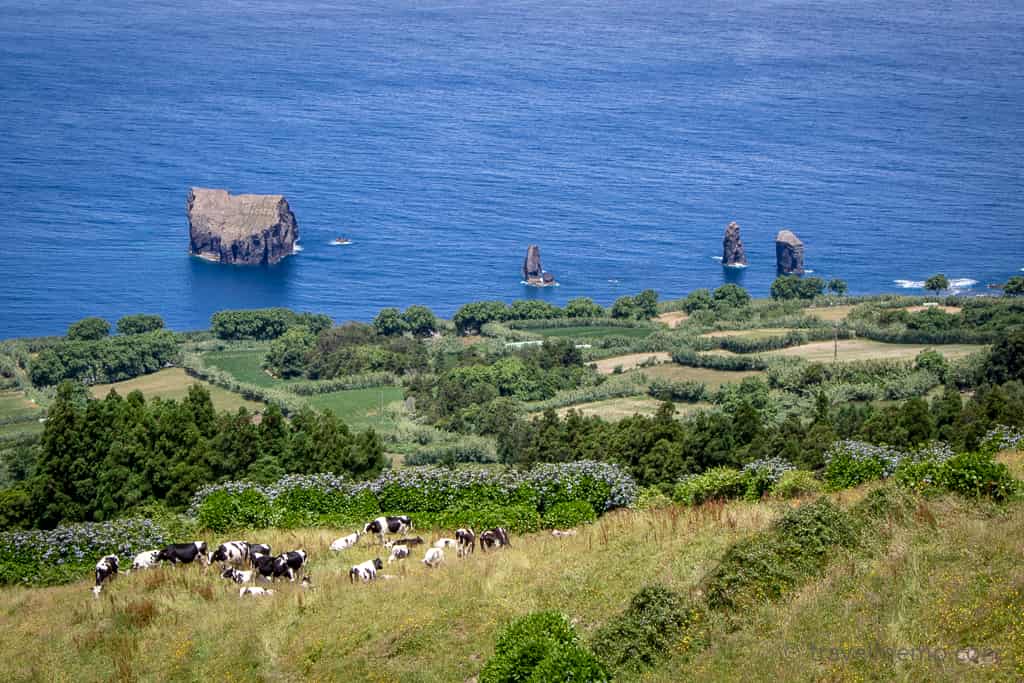
Although the travel guides say that each of the islands has its own charm, we settle on the main island. For one thing, it promises enough geographical variety: volcanic terrain with beautiful crater lakes, bubbling hot springs, green meadows, picturesque waterfalls and subtropical flora.
In a nutshell – it’s a paradise for nature lovers!
And so, on to my tips for what to see and do on São Miguel:
The capital Ponta Delgada
This little island’s capital is quickly explored. A stroll through the Old Town with its pedestrian zone is a must. The harbor promenade with its restaurants and cafes is also very strollable. Ponta Delgada really doesn’t offer much more. Except maybe the airport …
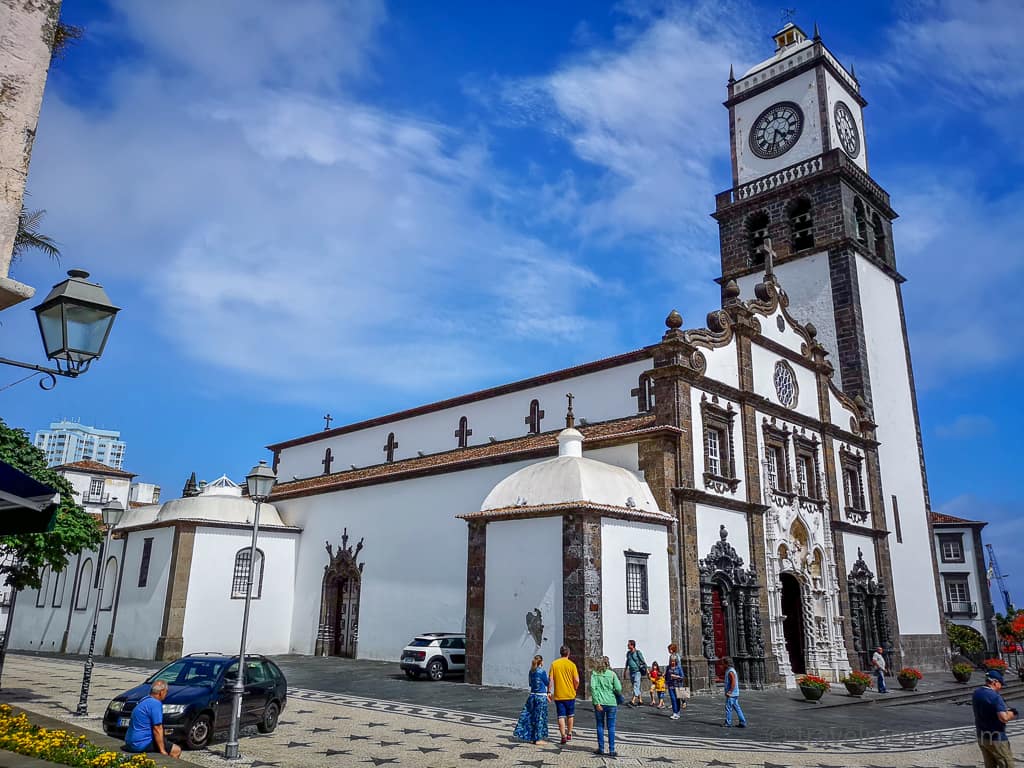
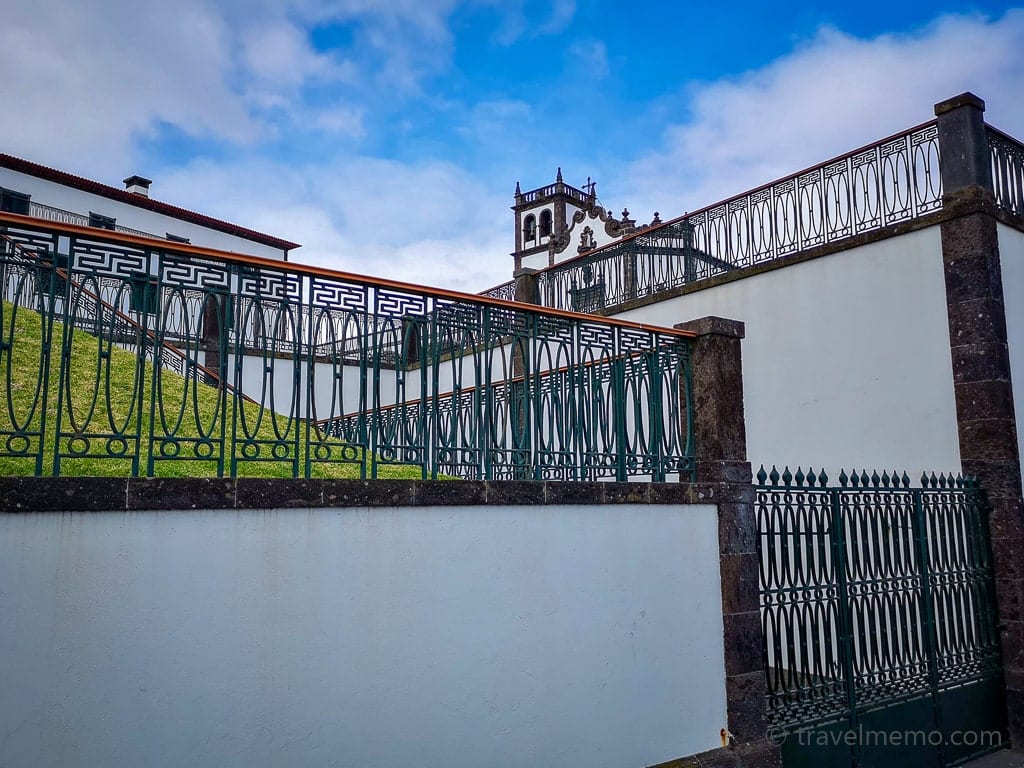
The volcanic crater lakes
The island’s west is home to the two largest lakes in the Azores. Here are the “Lagoa Verde” green lake and the “Lagoa Azul” blue lake. Both are in a caldera bisected by a drivable arched bridge.
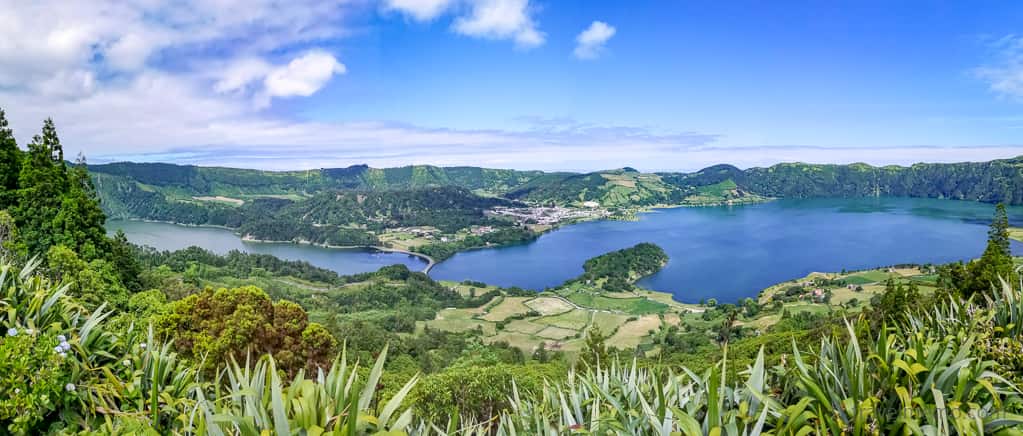

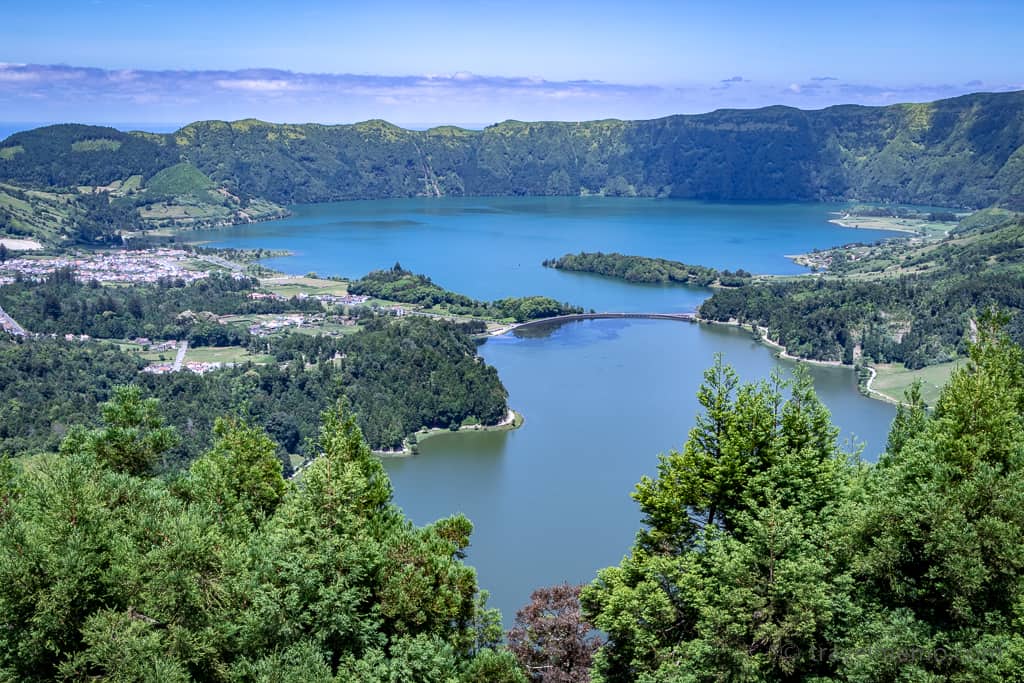
The “Vista do Rei” royal lookout offers a sensational view of the twinned lakes and Sete Cidades village. Do a one-eighty on the spot and you will catch sight of the shoreline ruin of the former “Monte Palace” luxury hotel.
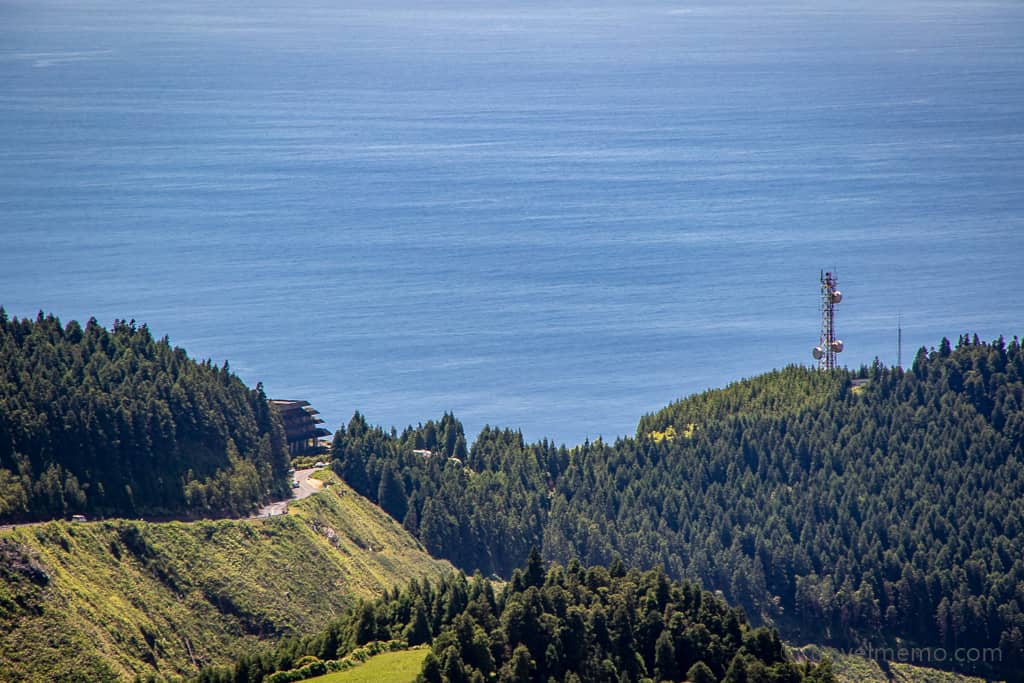
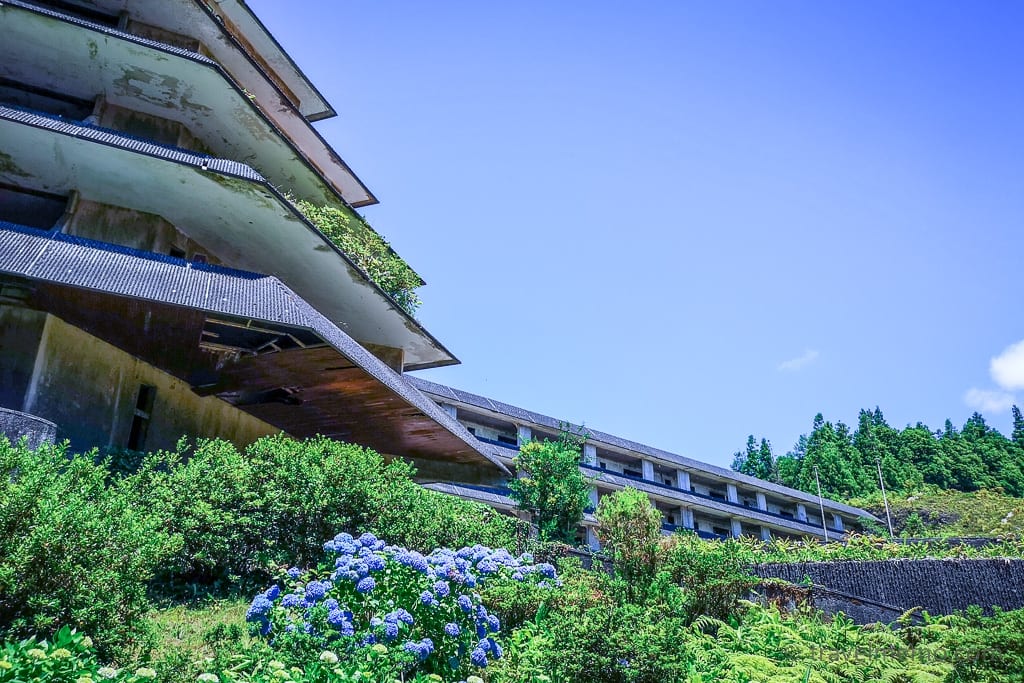
But the view from the “Miradouro da Boca do Inferno” vista point is even more spectacular! Because it also lets you take in Lago de Santiago along with the blue and green twin lakes.
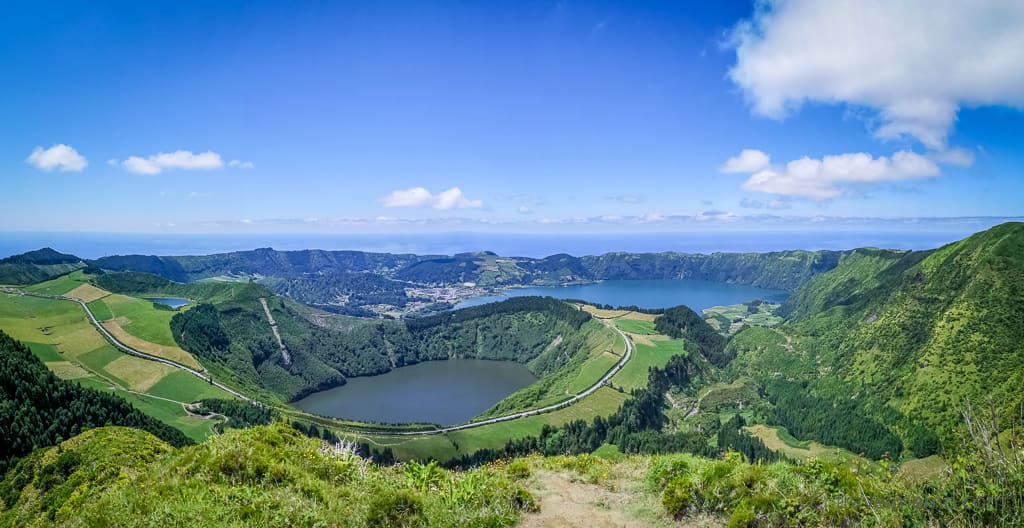
We nearly did not find our way to the famous Boca de Inferno lookout point because there are no signs with its name pointing to it.
A travel guide was nice enough — allegedly because we were Swiss — to clue us in on how to reach the lookout. We are happy to pass on the tip: it takes a 15-minute walk from the parking lot next to another lake, the Lagoa do Canário. But when you get to the vista point, you find all kinds of nationalities…
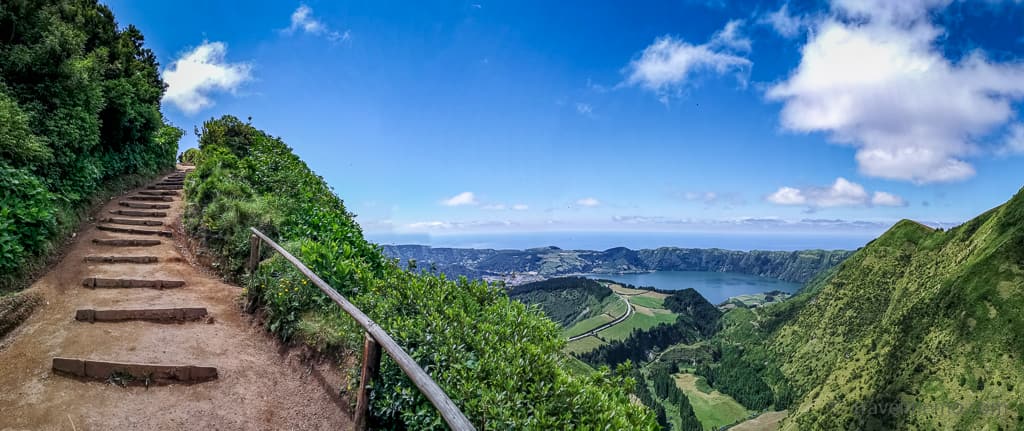
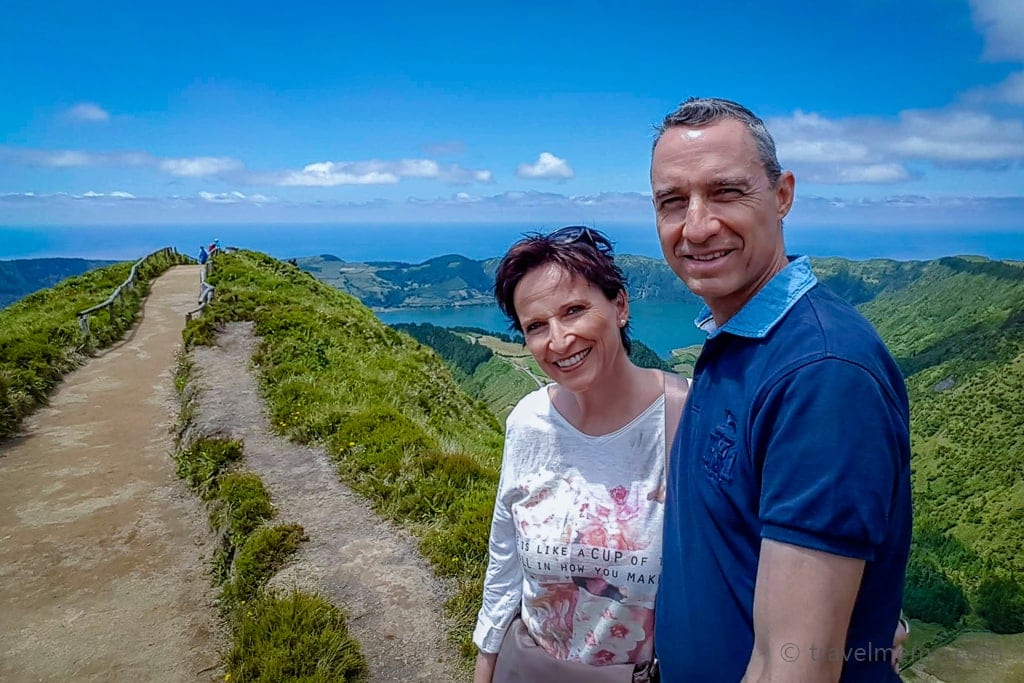
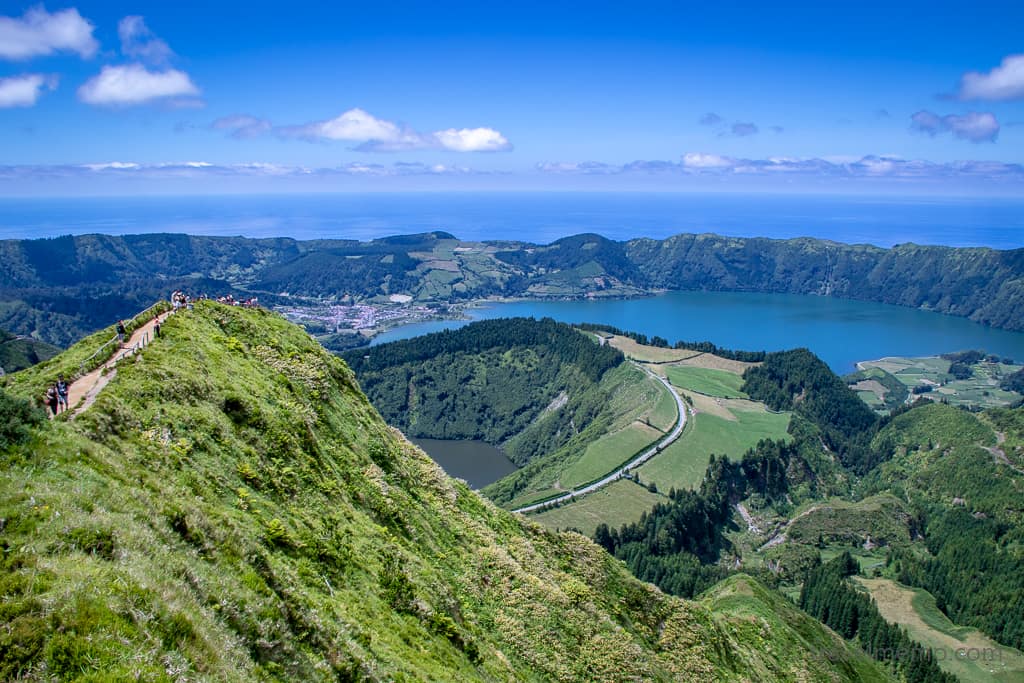
And as long as we’re on the subject of lakes, there is another one: the nearly 100-feet deep “Lagoa do Fogo” in the island’s central highlands. The surrounding volcanic peaks offer a matchless view. Has to be seen to be believed!
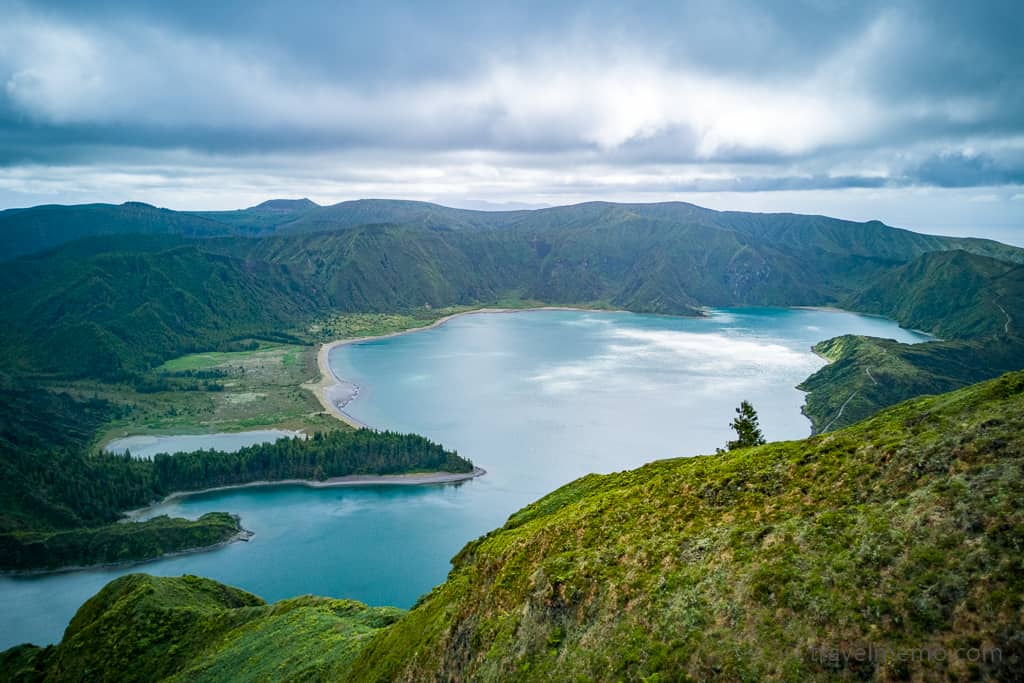
The coast and its “miradouros”
The island is rife with miradouros (lookout points) and “parques de merendas” (picnic grounds). They are all beautifully maintained and most really do offer splendid views of the coast or little rocky islands like the “Ilhéu dos Mosteiros”.
We decide we’ll call the latter the “12 apostles, in reference to the famous Australian members of their species ;-)
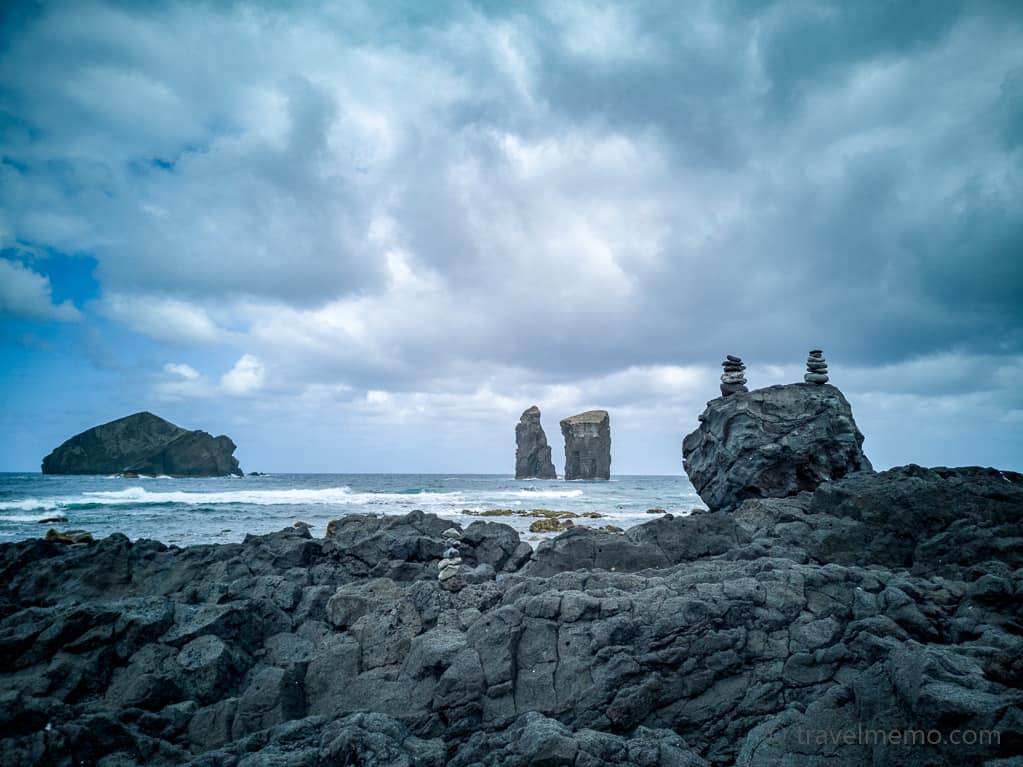
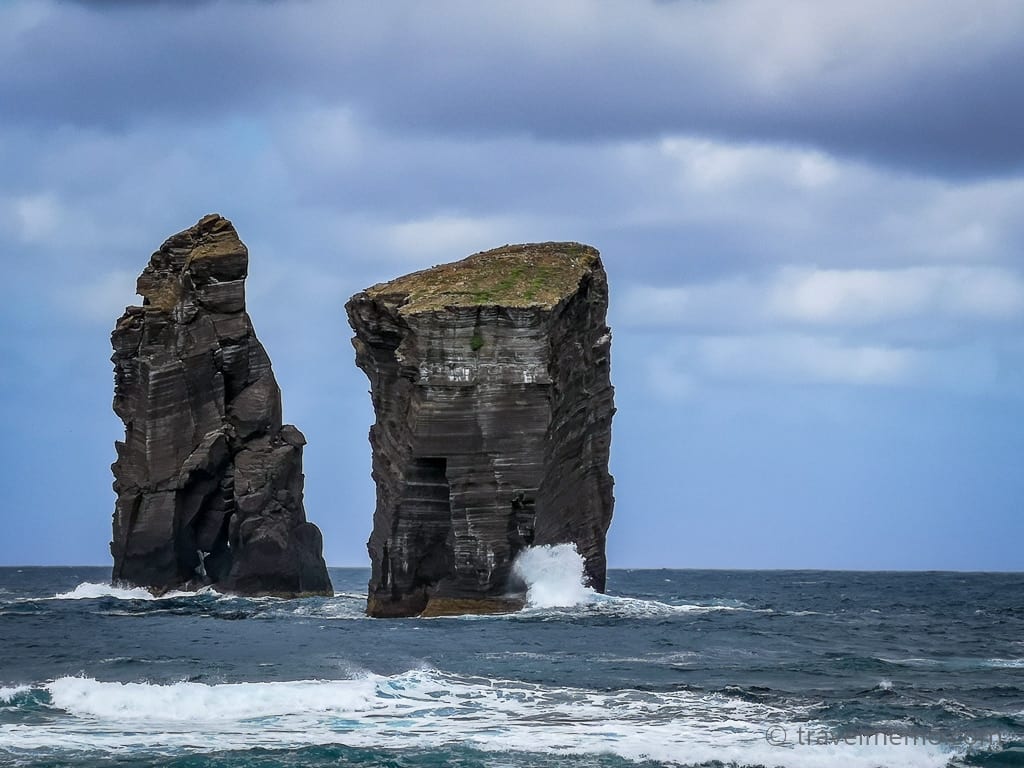
The coast line is impressive, with its sheer cliffs, lovely inlets and the black basalt rock or beaches of black volcanic sand.
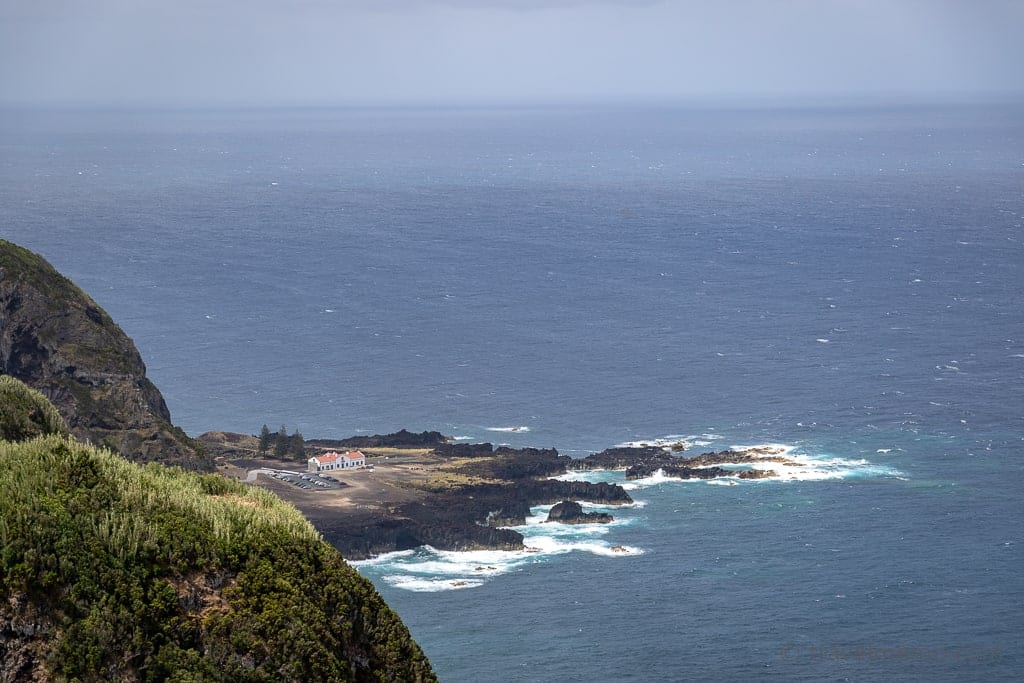
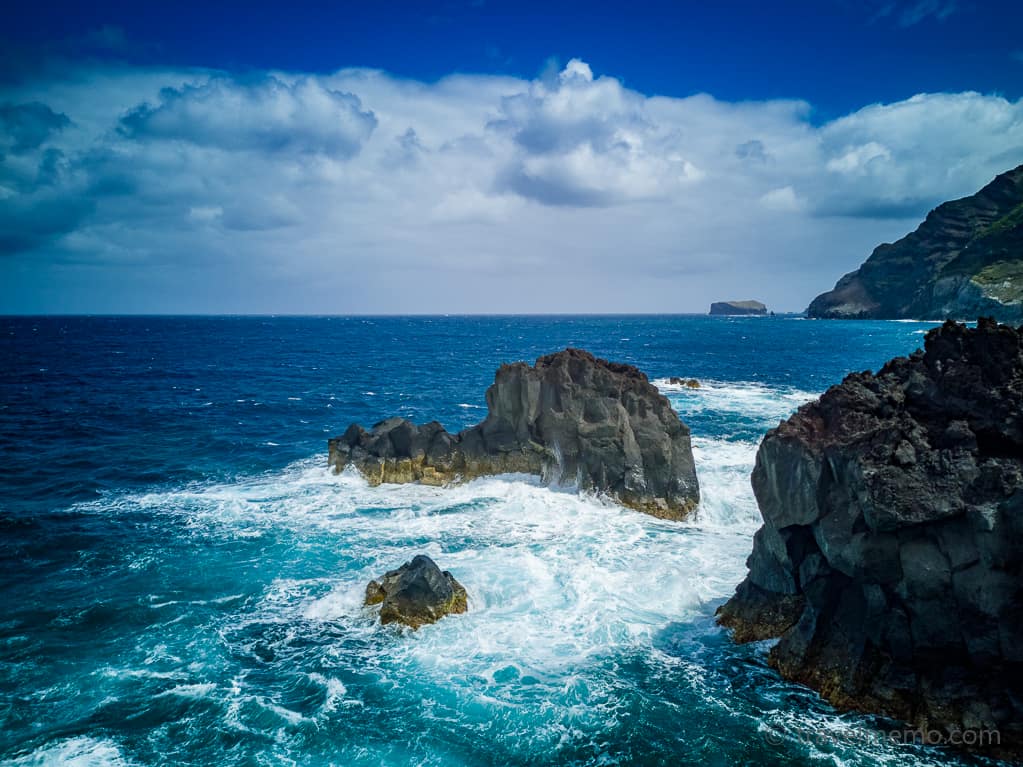
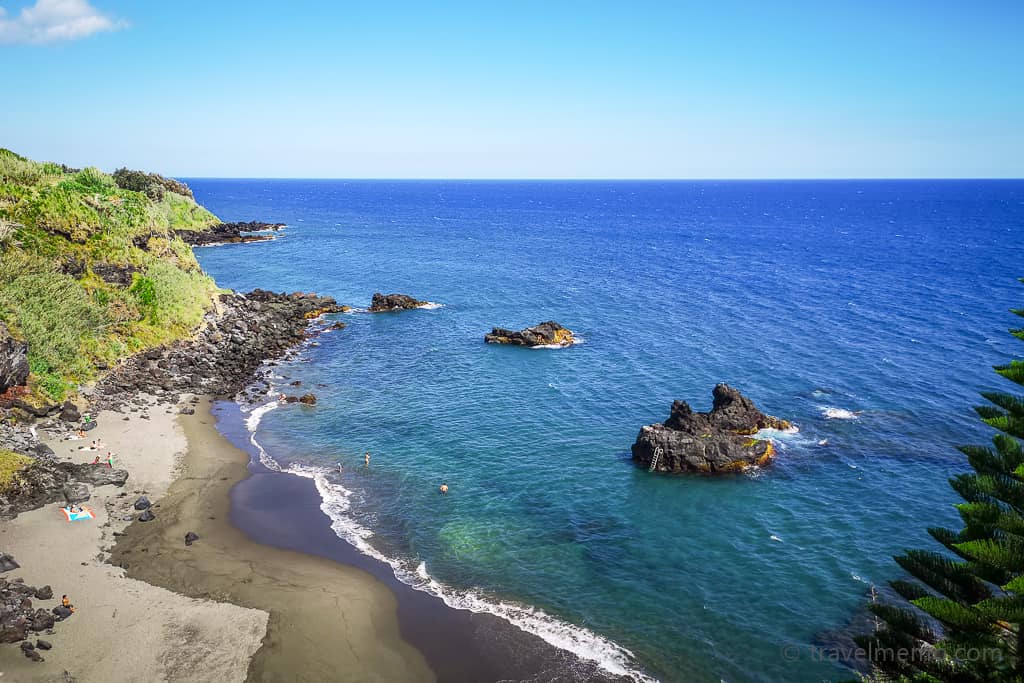
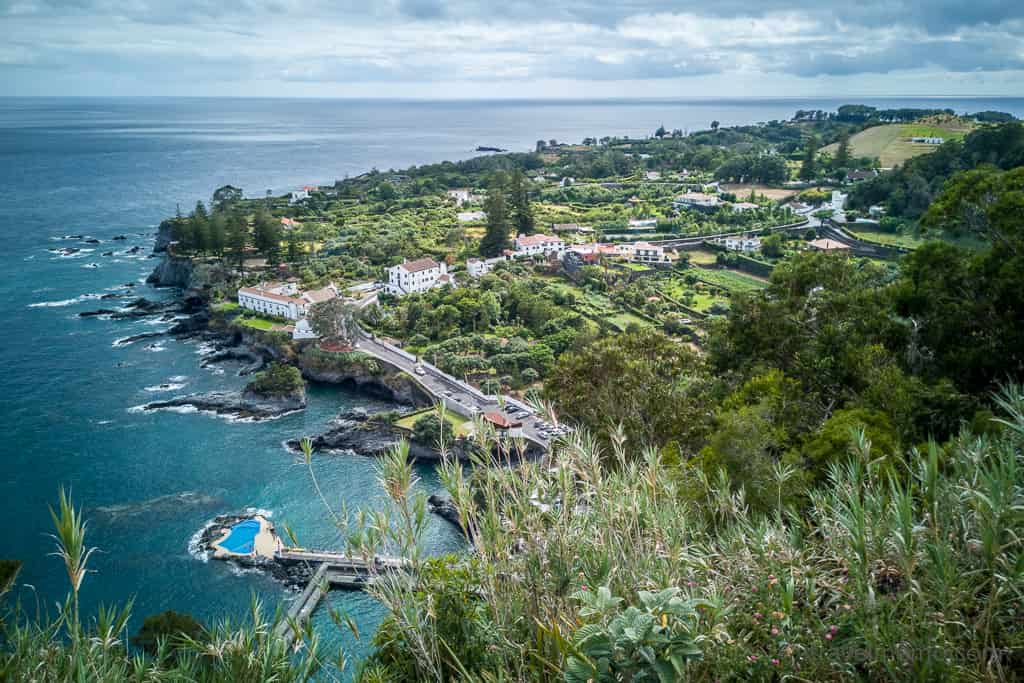
As it were, I was not terribly attracted to the black beach for a swim. Besides, the waters of the Atlantic are famously chilly.
In Ponta da Ferraria, however, there is a rarity: in the little bay here the water is warmed by hot springs! But there were so many touristas splashing around that we stayed out of the water.
Caldeiras – bathing in hot springs
In several locations on São Miguel, you will find natural pools fed by hot springs called “caldeiras.” One of the largest is the “Caldeira Velha” between Ribeira Grande and Lagoa do Fogo.
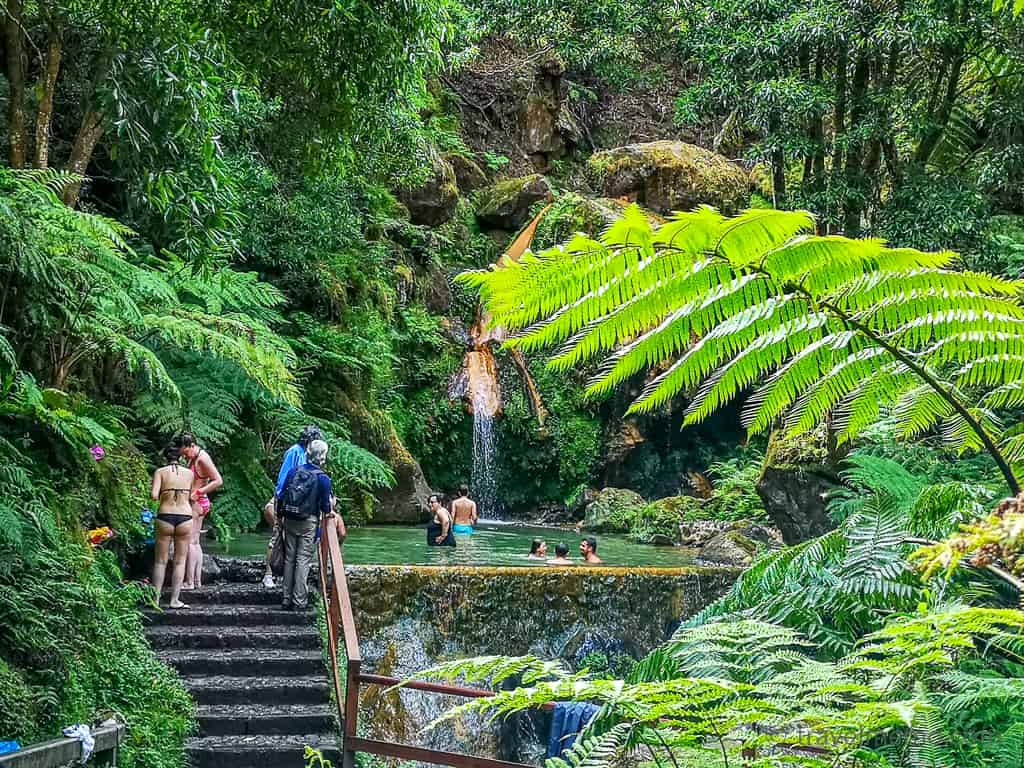
There is another natural pool at Furnas that also contains healing mud. This is the “Poça da Beija” a bathing landscape with several hot springs.
And right in the middle of the “Parque Terra Nostra” you come upon a hot springs pool with very iron-rich, dark-yellow water.
Frankly, the peasoupy color, not to speak of the sulfurous smell redolent of rotten eggs, are not that inviting in my book. But a dip in a hot springs bath simply goes with being in the Azores. The water does indeed have a high iron content that can be very beneficial for the skin and for rheumatism.
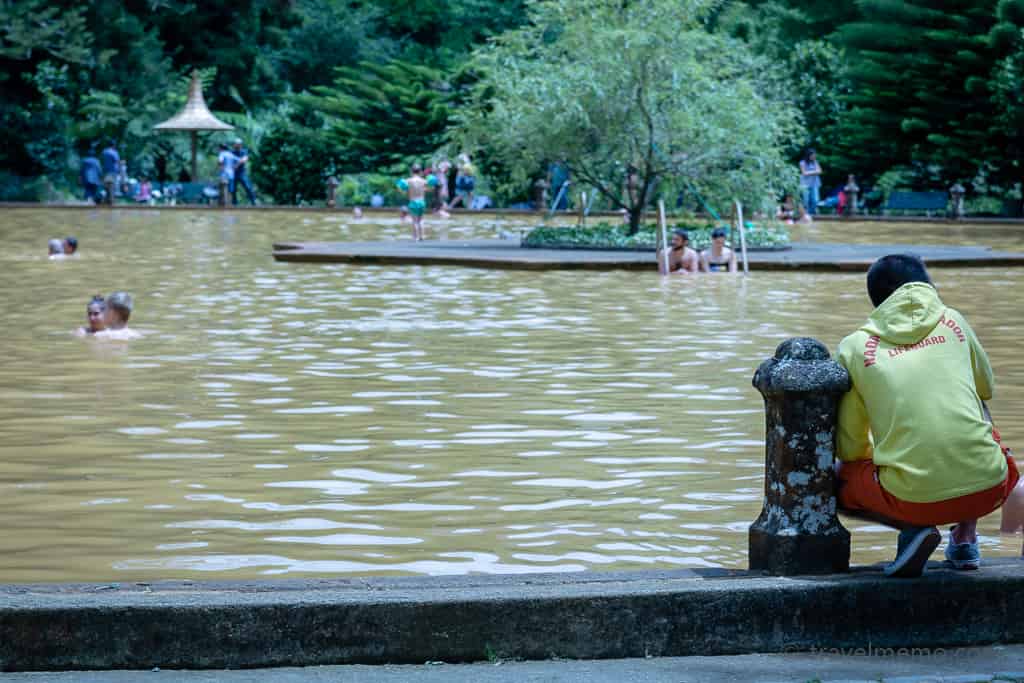
Parque Terra Nostra in Furnas
The park, in any case, is a must-see when visiting São Miguel. It is a green oasis with a unique collection of trees, plants, and flowers from around the globe.
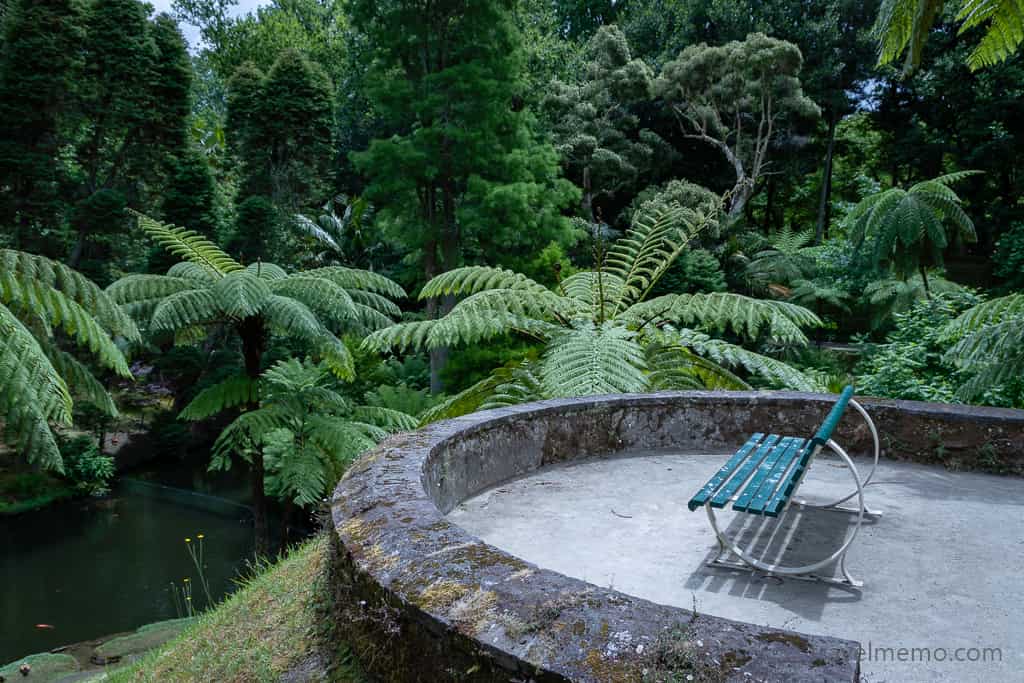
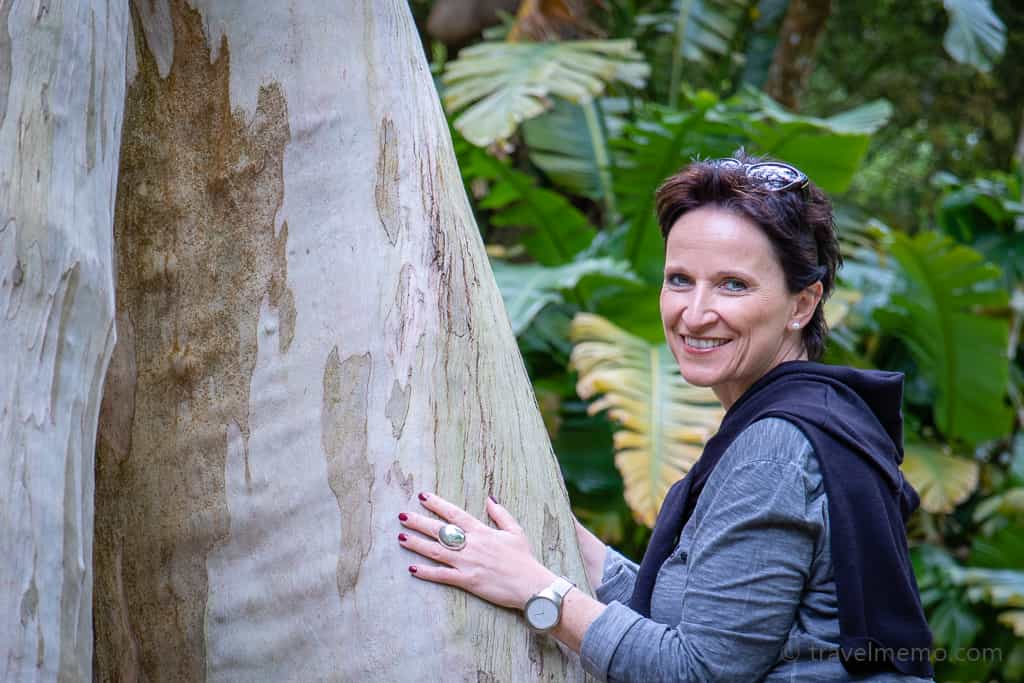
A small brook babbles from pond to pond. It’s warm thermal spring water! And if that weren’t enough of a cliche, there are two black swans gliding on the water!
The park contains a first-rate botanic garden. It boasts a beautiful water lily pond and countless exotic plants from every continent blessed with flora. It reminded us of the botanic garden in Mauritius. Similar but also completely different…
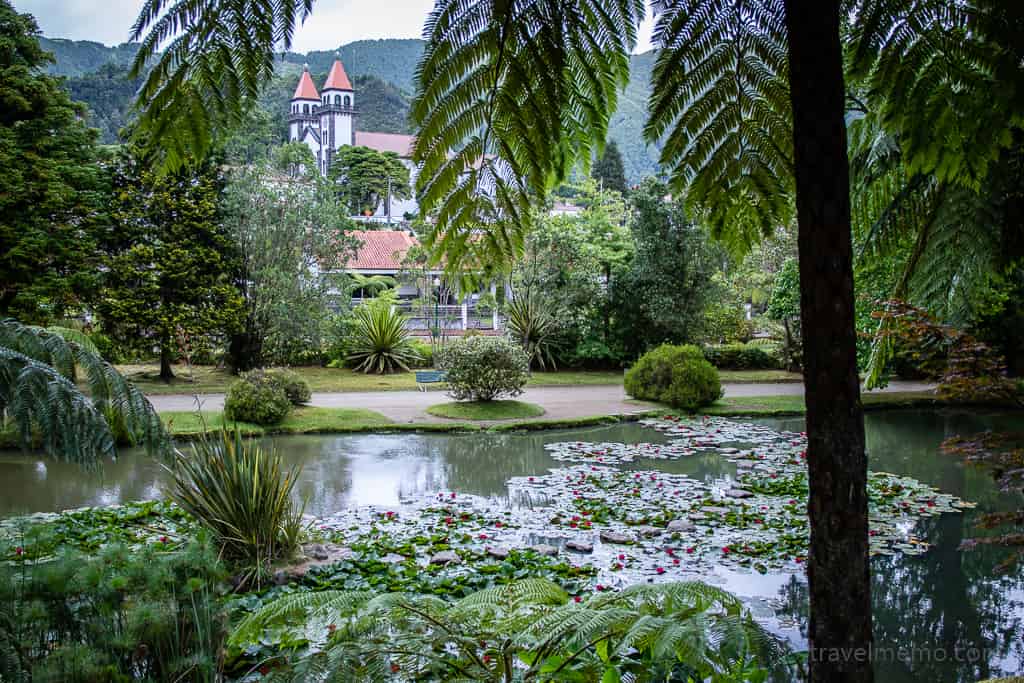
Furnas and it geysers
Furnas is a health resort located in the crater of an extinct volcano in the southeastern part of the island.
The lake of the same name (Lagoa do Furnas) on the edge of Furnas is known for its hot vents (fumarolas). They steam and bubble all around. The locals use these fumaroles for preparing “cozido“, a pot of stew that they let simmer slowly for up to seven(!) hours in the steamy vents.
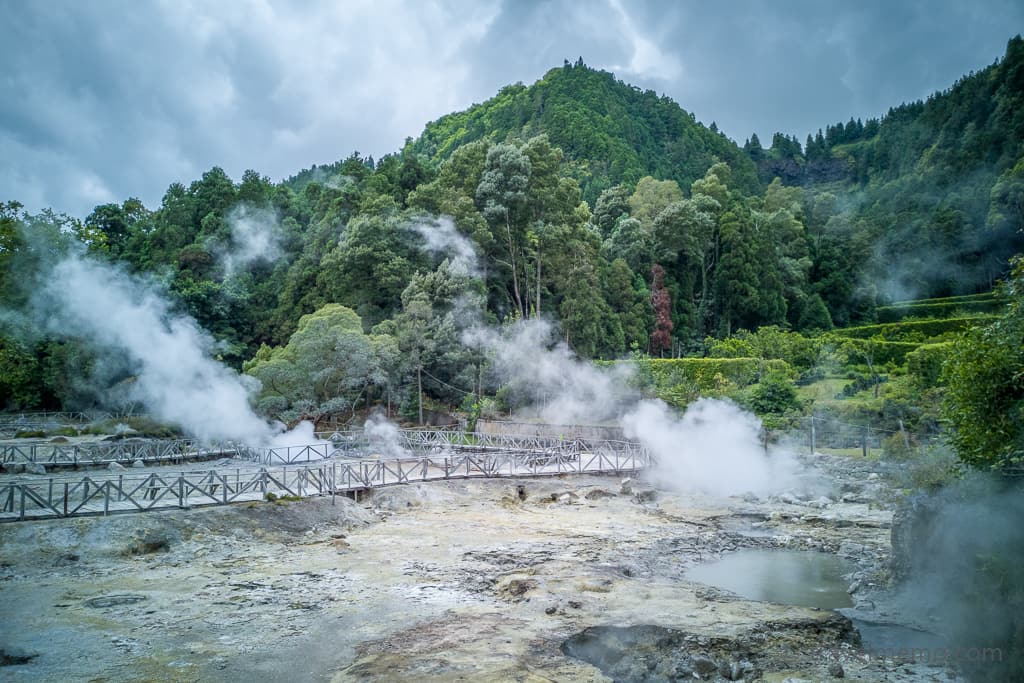
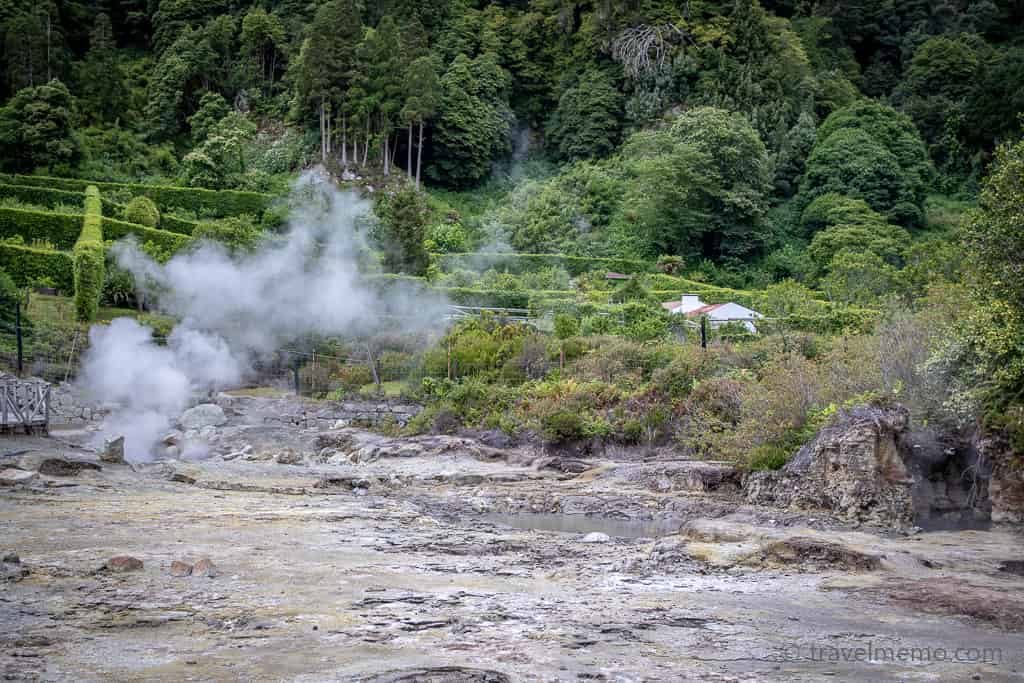
The best view of the Lago do Furnas and the sulfur-draped geysers, incidentally, is to be had from the “miradouro do Pico do Ferro”. An intimidatingly steep climb up from the parking lot by the geysers is best left to the fit visitor.
The mountain’s other side is much less steep, however, so you can practically drive up to the lookout point on the very moderate incline.
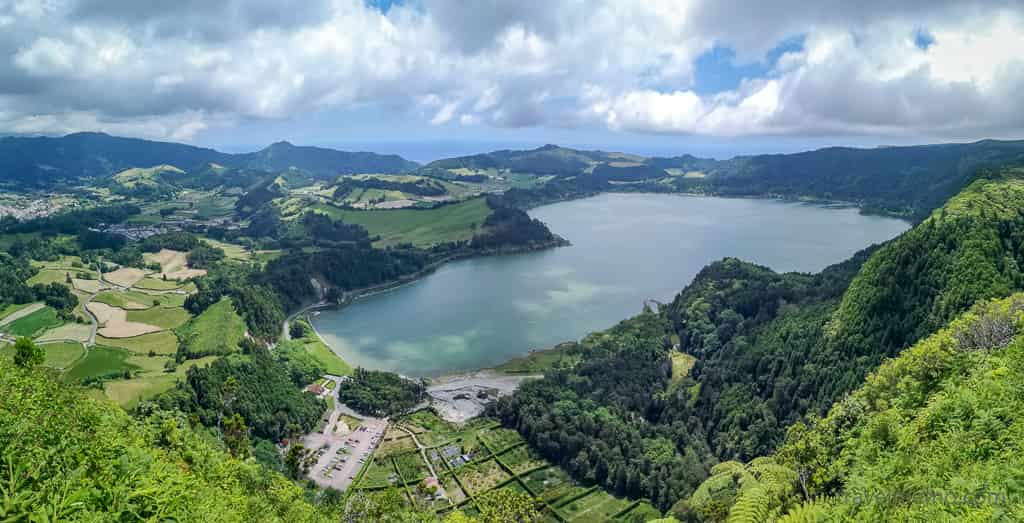
The Cha Gorreana tea plantation
Europe’s only tea plantation is found on the Azores!
On the hillsides between Maia and São Bras in the island’s northern part grow the lush green tea shrubs worked by the Gorreana family business.
They produce up 40 tons of black and green tea here annually. Most of it is cultivated by hand, as is the harvesting and processing.
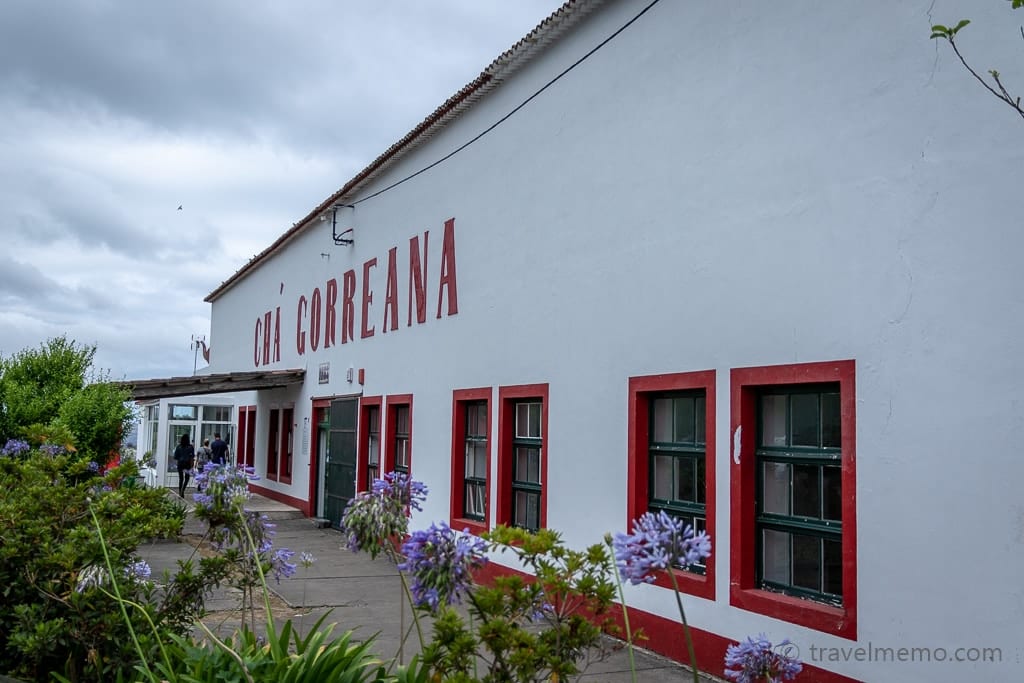
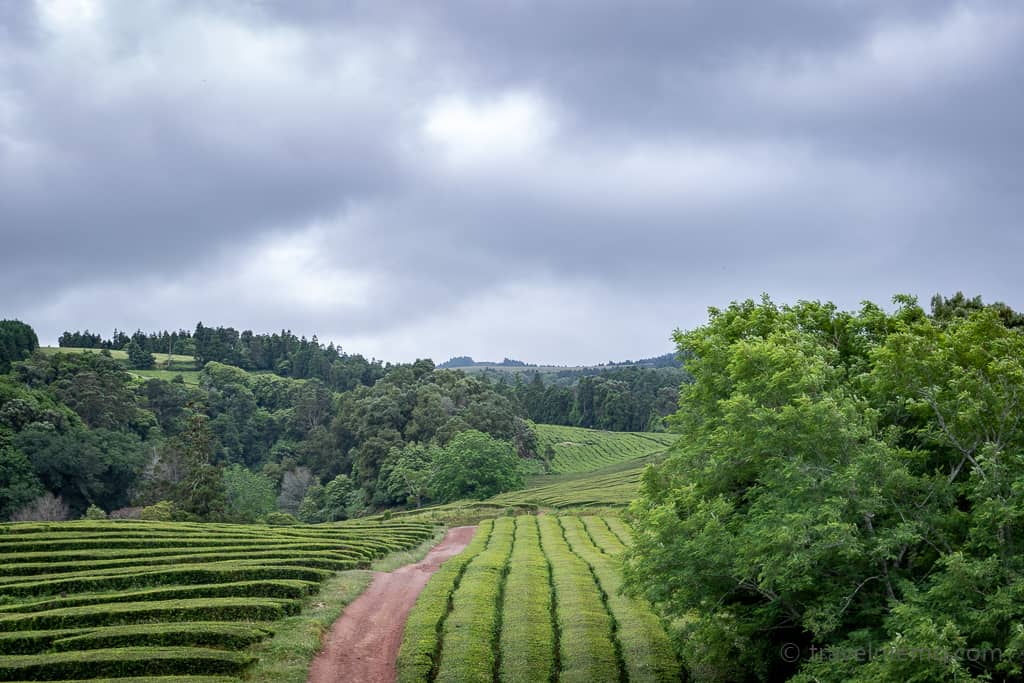
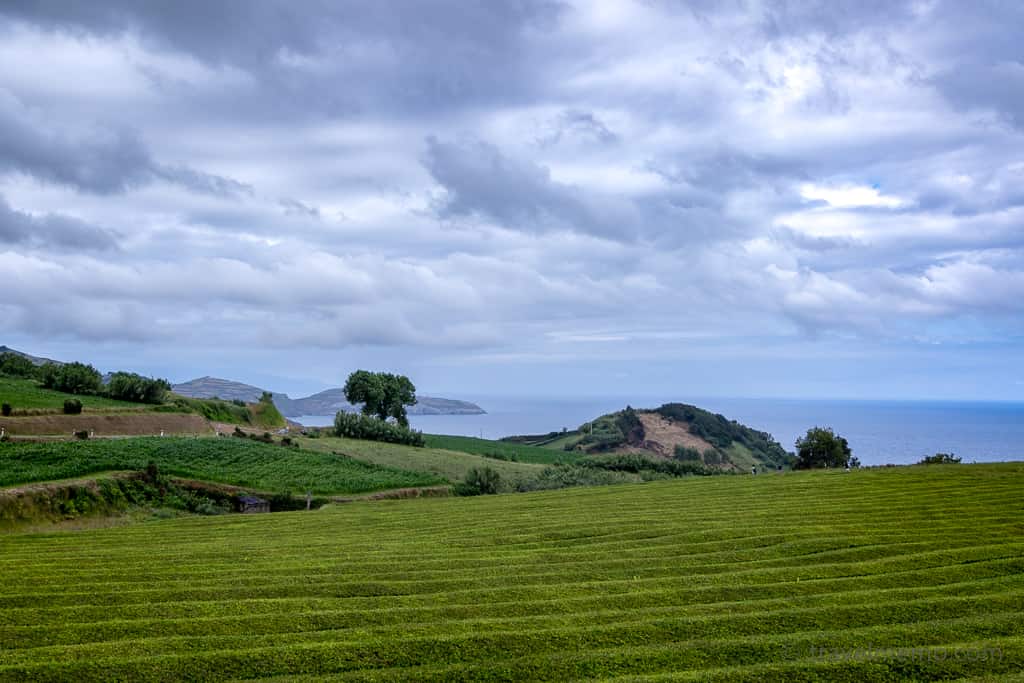
The Farol del Arnel lighthouse
At land’s end in the island’s northeastern part by the village of Nordeste stands the Farol del Arnel lighthouse. The spot offers a super panoramic view of the coast and the Atlantic. It is one of the oldest lighthouses on the Azores.
But watch out! We absolutely recommend not driving down the steep switchback street. With a 35% grade, it is really steep, has few crossroads and not every run-of-the-mill rental car will make it back up the road without problems ;-)
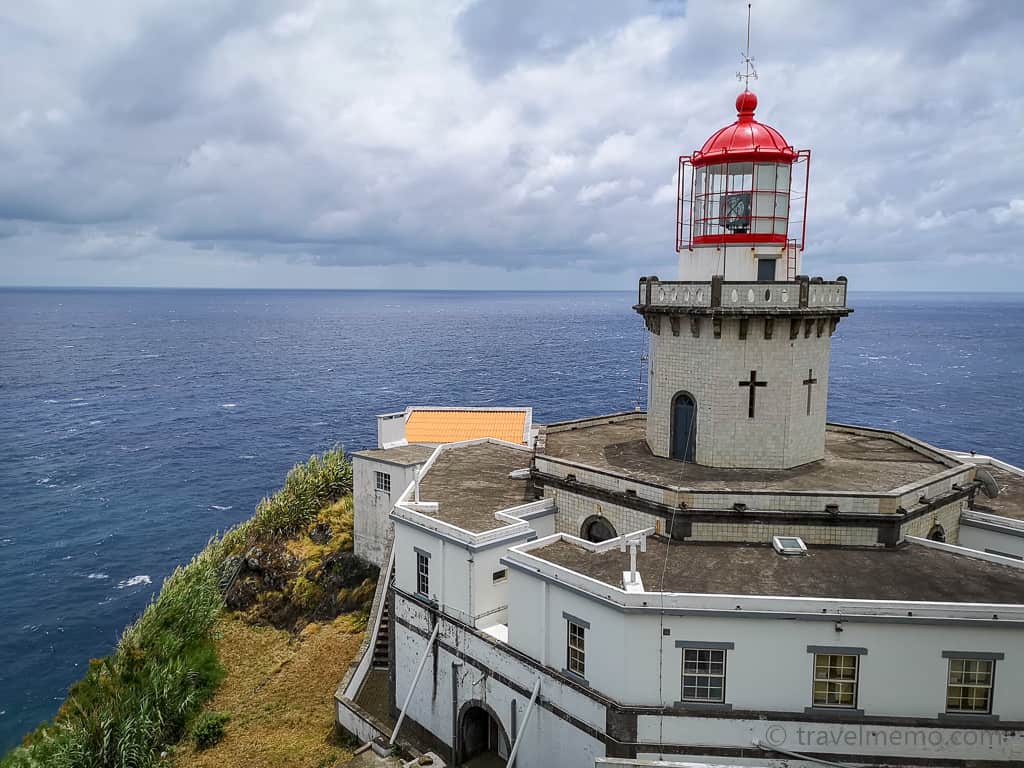
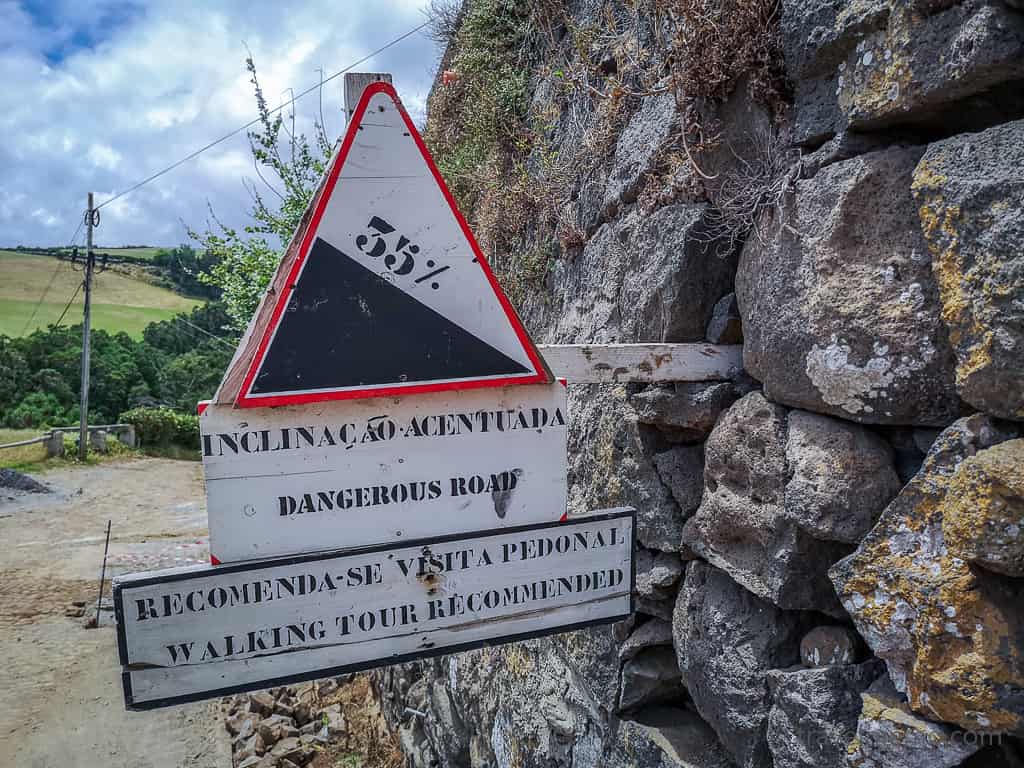
Parque natural de Ribeira dos Caldeirões
In the vicinity of Nordeste, in the Parque natural de Ribeira dos Caldeirõe, you can go canyoning. We’re not into that kind of adventure, but a stop here is worth it, even if you don’t have a hankering to rappel down sheer cliff faces.
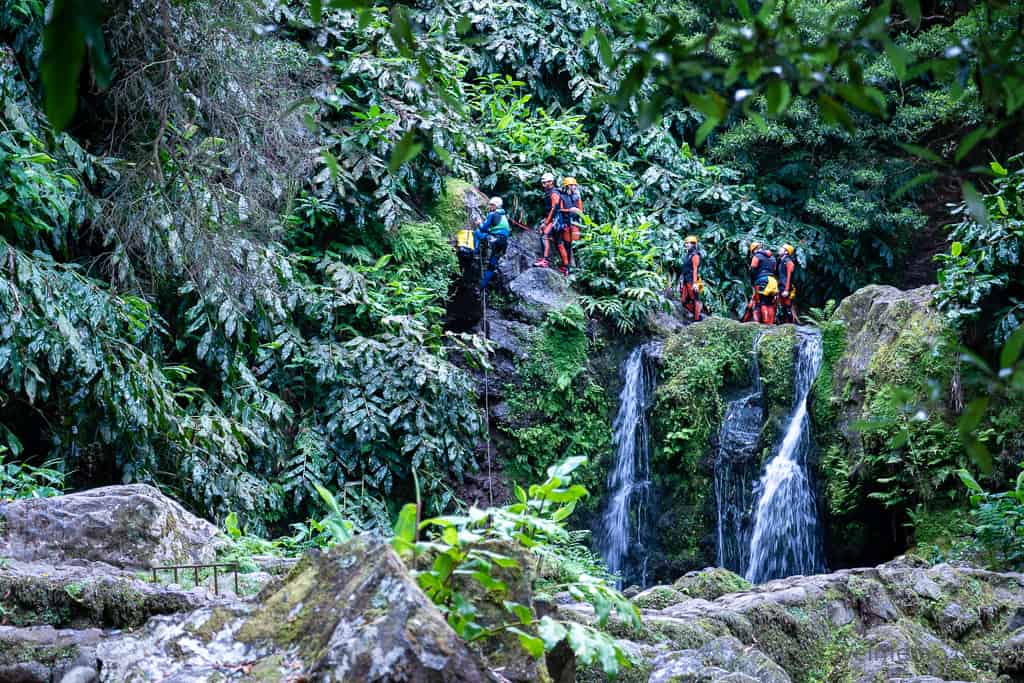
This nature part is really well laid out, into luxuriant vegetation with tree ferns and cedars. Add to it that a river meanders through the park and there is also a small waterfall to be admired. Or you can visit the restored watermills downriver. So idyllic!
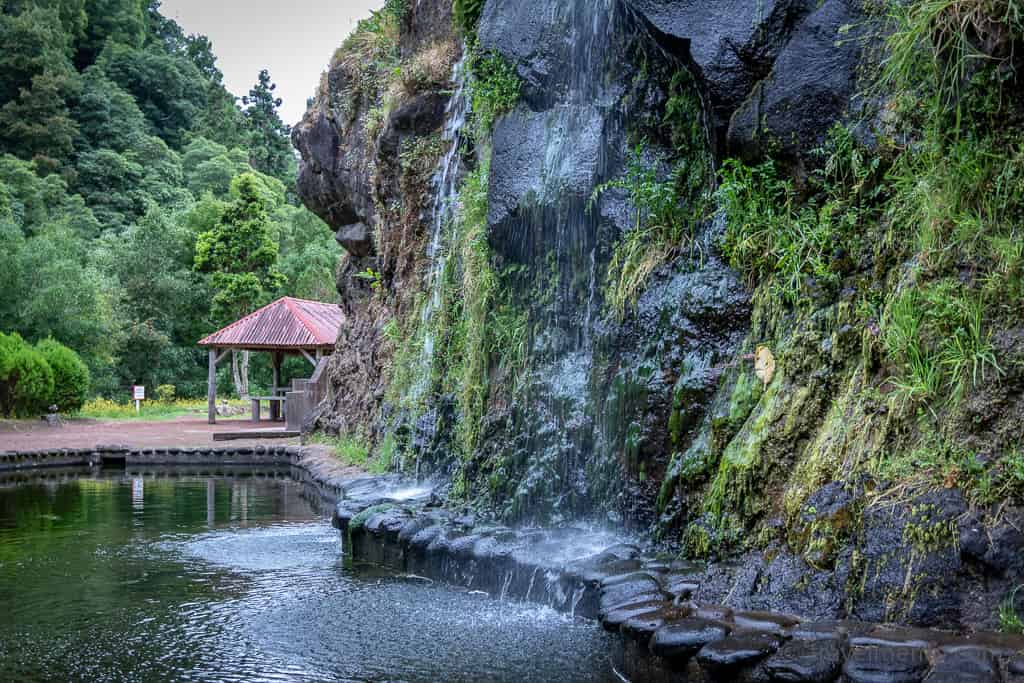
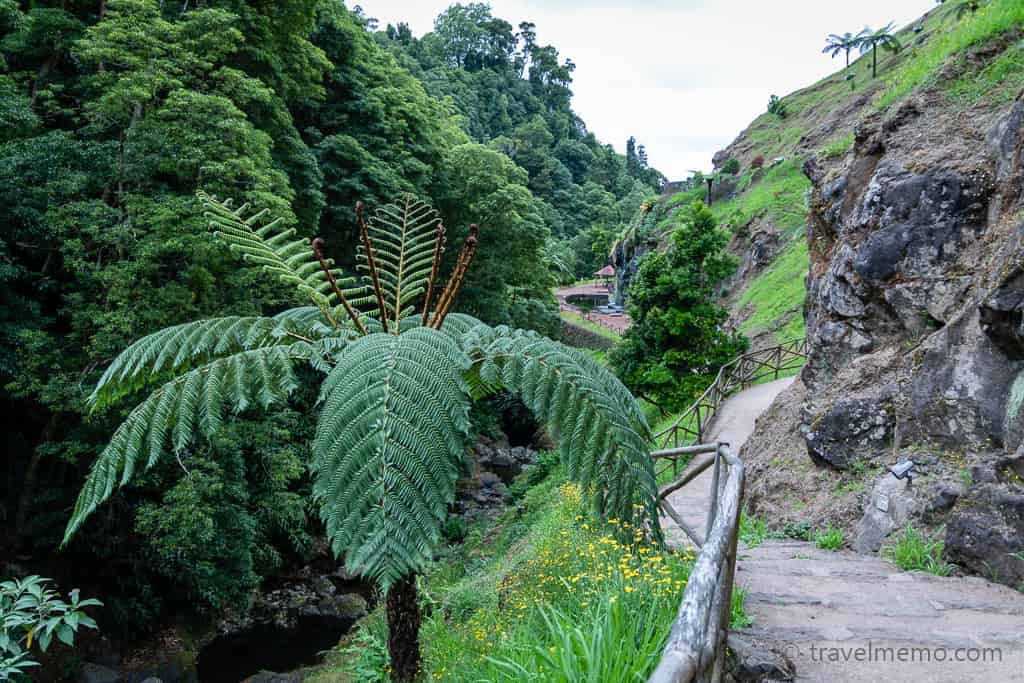
The golf courses
Yesss! They actually have two golf courses on São Miguel! The 27-hole Batalha course spreads out on the island’s north coast. On one side you see the Atlantic, on the other side in the south and east an imposing mountains chain curves around the course.
Here, too, once again the island’s green meets the blue of the ocean, producing a beautiful interplay of colors — at least when it’s not cloudy or the fog moves in…
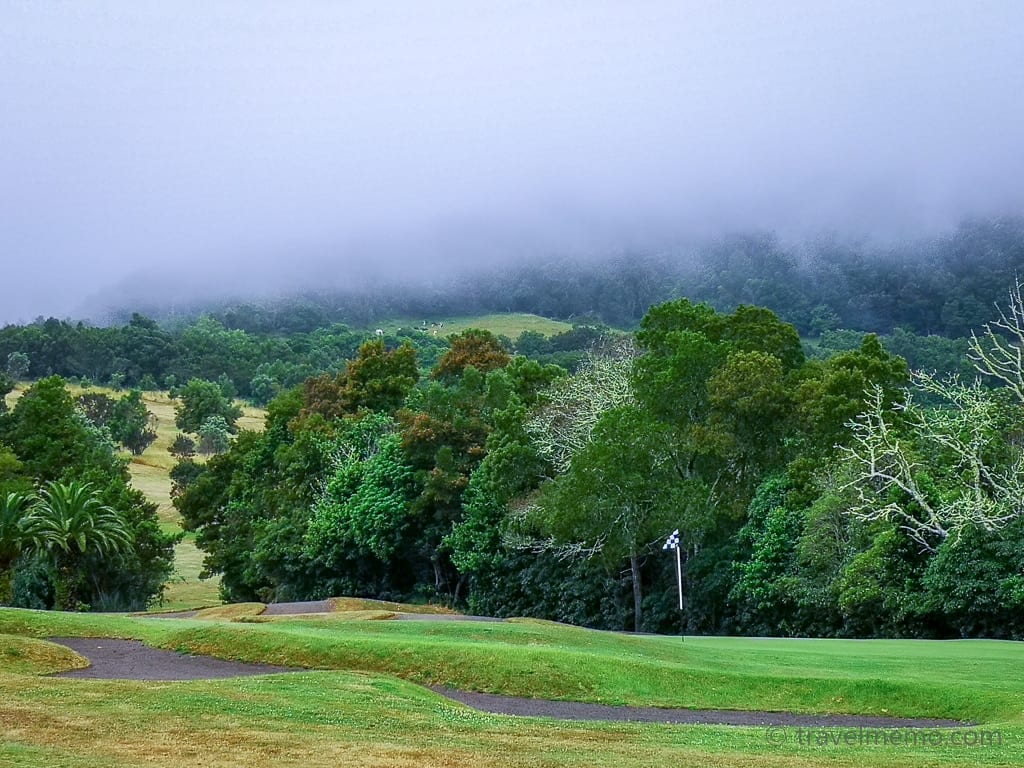

The 18-hole Furnas golf course is equally spectacular! It is situated in a volcanic landscape with lush, tropical flora.
Not so great, as far as I’m concerned, are the many, deep sand bunkers and the rather undulating greens. They’re the only reason Walter beat me on this course!
He sees it differently, which is understandable, considering that it is the first time in years that he finally managed to win a round…
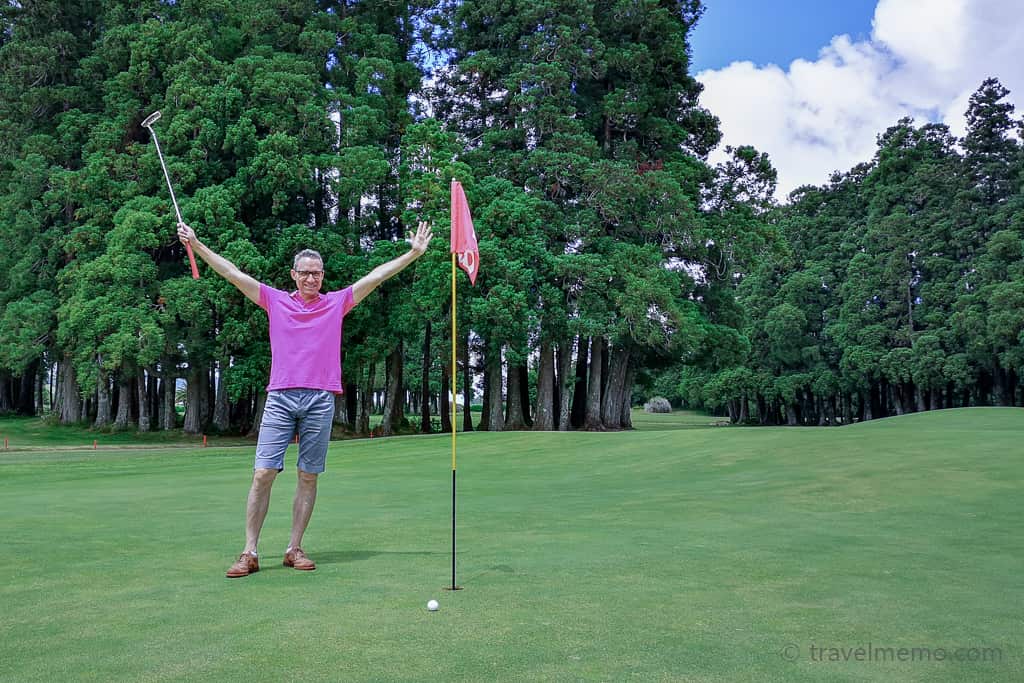
Getting to São Miguel
From Switzerland, our home base, Air Portugal (TAP) will get you to the Azores’ São Miguel island, although with a stop in Porto or Lisbon. TAP at present has an attractive Stopover Program, which makes it easy to combine your Azores vacation with a stay in one of the two cities.
We took their offer and spent 2 days in Porto getting acquainted with the city.
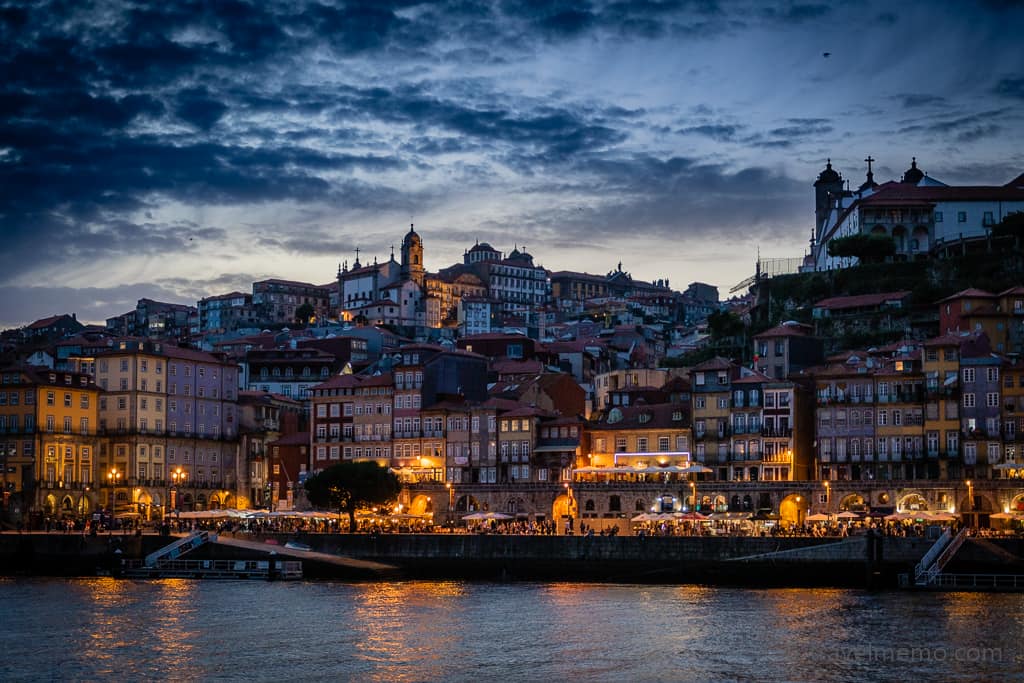
We also have tips for Lisbon for you.
It’s a 2 1/2 hour flight to Ponta Delgada in the Azores from Porto or Lisbon. Apparently there are also direct flights to the Azores out of Boston and New York.
To see at much as possible of the island, it is best to explore it in your private rental car. Tip: don’t take the smallest one! In places, it’s quite a steep grade down to the coast or up the mountain.
And, on some washboard roads, an SUV will do even better. On the other hand, the car should not be too big either, given the tight little alleys in the villages. A Nissan Qashqai worked well for us.
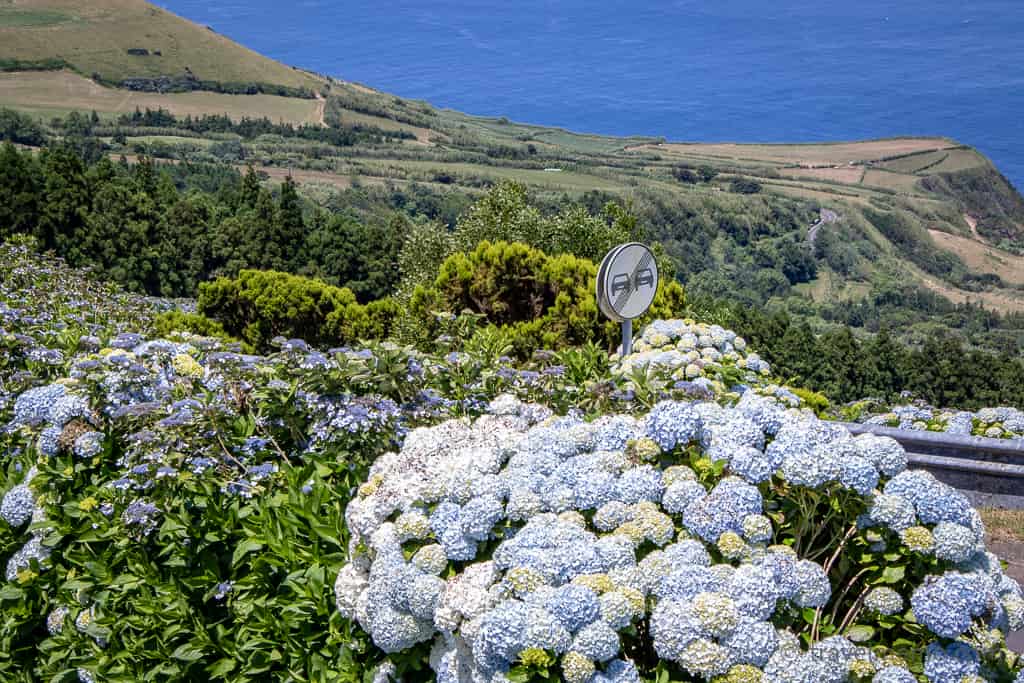
Timezone: Central European Time minus 2 hours.
Best time to be there
The Azores are a year-round destination; winters are mild, summers, with temperatures averaging in the mid-70s (Fahrenheit), are pleasantly warm. The best travel season is from June to September, when there is the least precipitation.
It so happens that during our June visit, we also had very changeable weather, which is typical for Azores: sunshine can quickly turn into wind and overcasts followed by rain. It works the other way, too, and sometimes more than once during the day!
Lodgings on São Miguel
We found two very stylish hotels that we can most heartily recommend to all fans of boutique and design hotels:
Santa Barbara Eco-Beach Resort in the island’s north and…
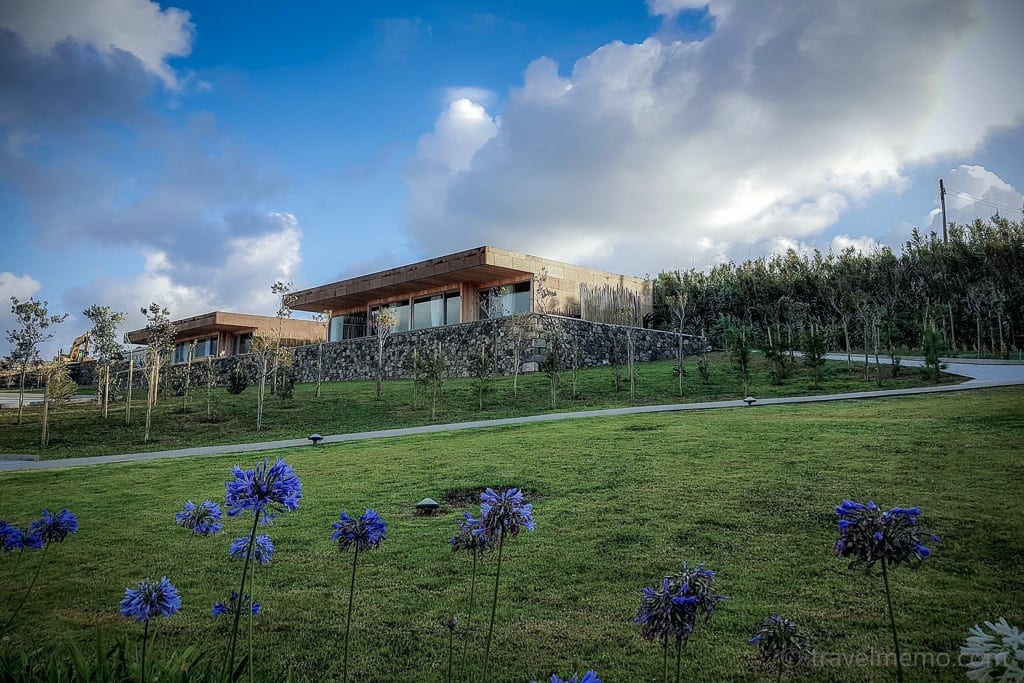
…the WHITE Exclusive Suites & Villas near Ponta Delgada.
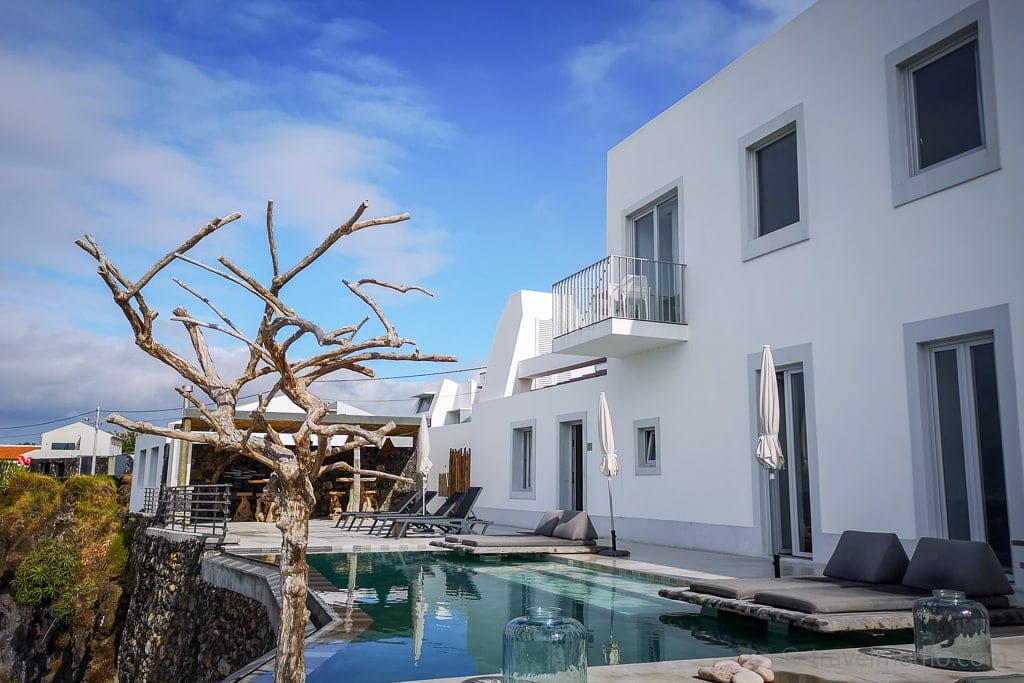
Another hotel recommended by a fellow blogger with Travel Sisi is the Furnas Boutique Hotel. We stopped in for lunch there. Great job, Restaurant À Terra!
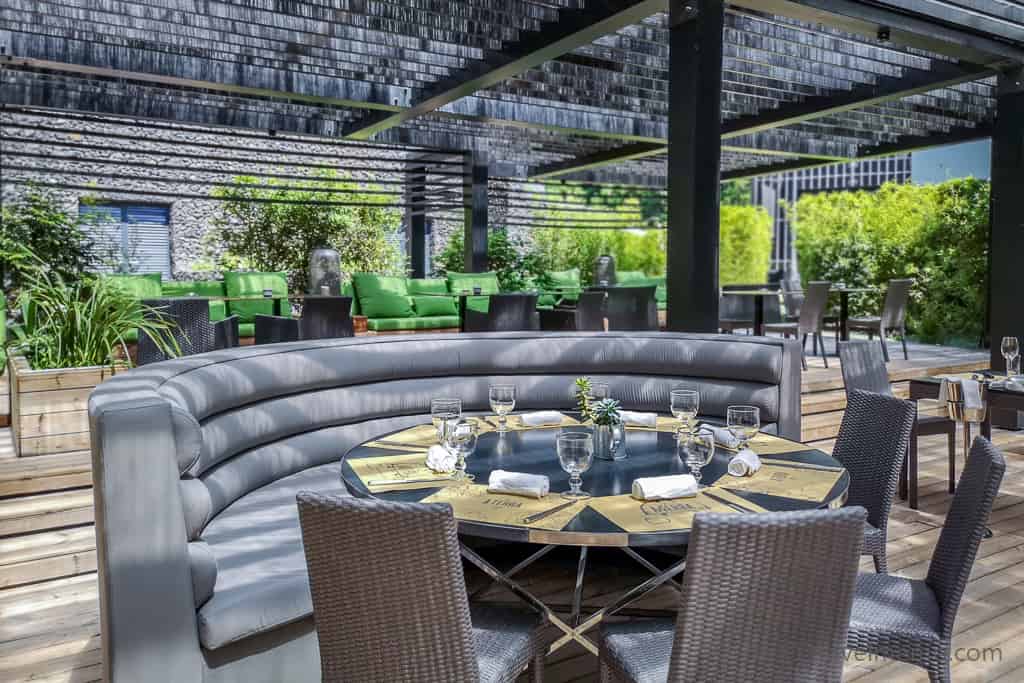
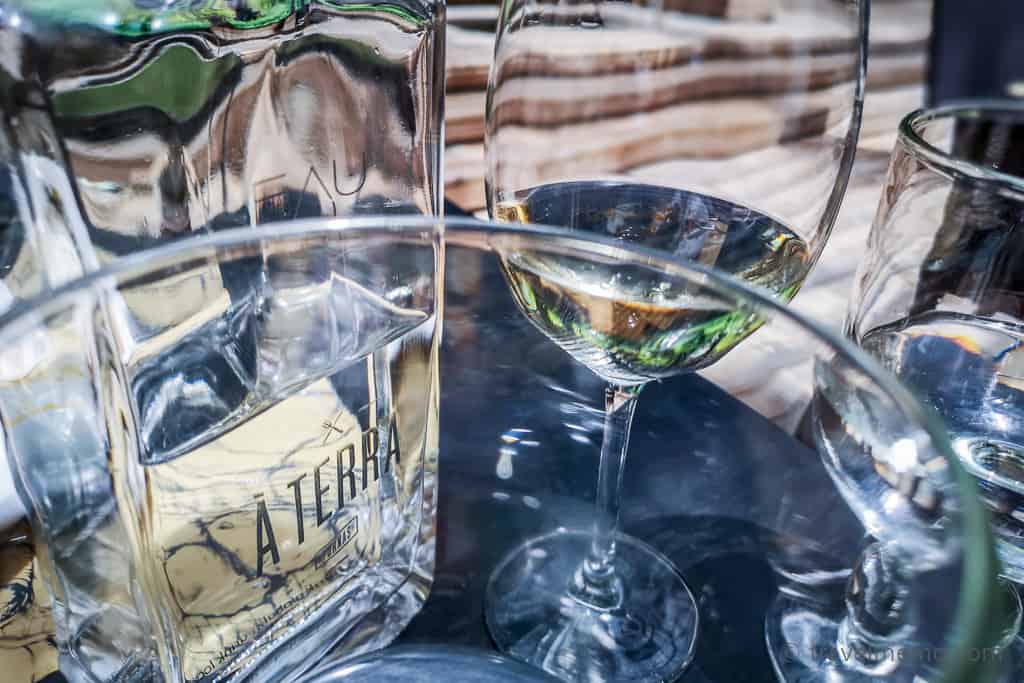
I wish everyone a richly varied, enjoyable stay on the “weather island” ;-)

